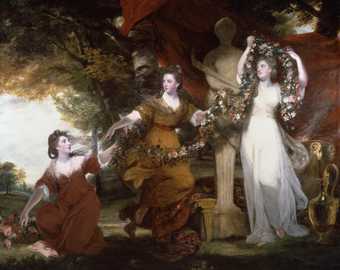
Sir Joshua Reynolds, Three Ladies Adorning a Term of Hymen 1773. Tate.
1760–1830
19 rooms in Walk Through British Art
The first era of public art exhibitions begins, bringing new audiences to British art. This gallery recreates the spectacle of these early displays
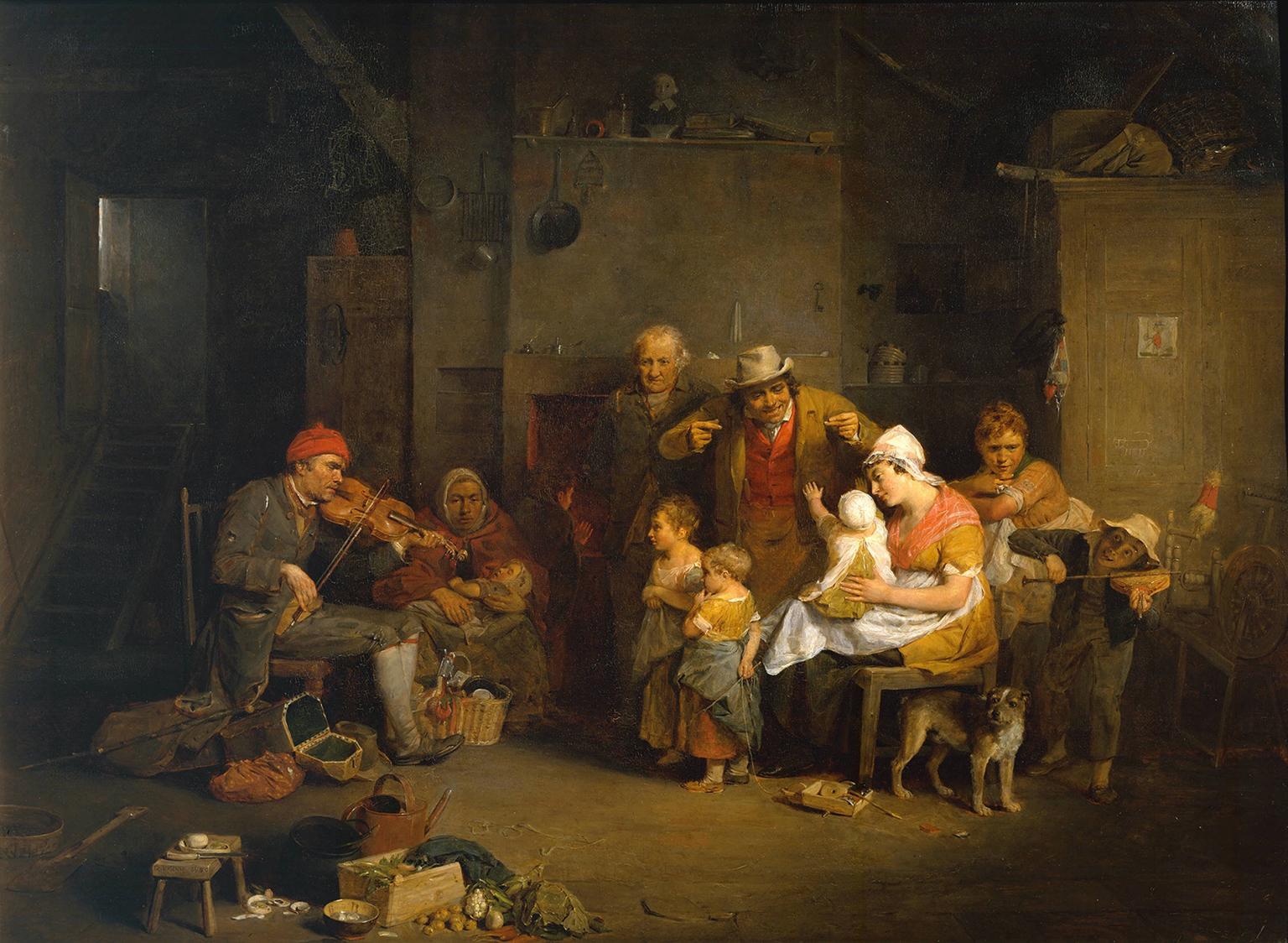
Sir David Wilkie, The Blind Fiddler 1806
In this early work by Scottish-born David Wilkie an itinerant fiddler is playing for a humble country family. Wilkie focuses on the listeners’ different expressions. Only two people seem to respond to the music: the baby and the boy on the right, who is imitating the fiddler by playing the bellows. When this picture was exhibited at the Royal Academy some critics thought the bust on the shelf represented a dissenting minister, and concluded that the family were nonconformists. The power of music to stir the passions of those supposedly suspicious of pleasure was thought to add to the painting’s subtlety.
Gallery label, February 2016
1/30
artworks in 1760–1830
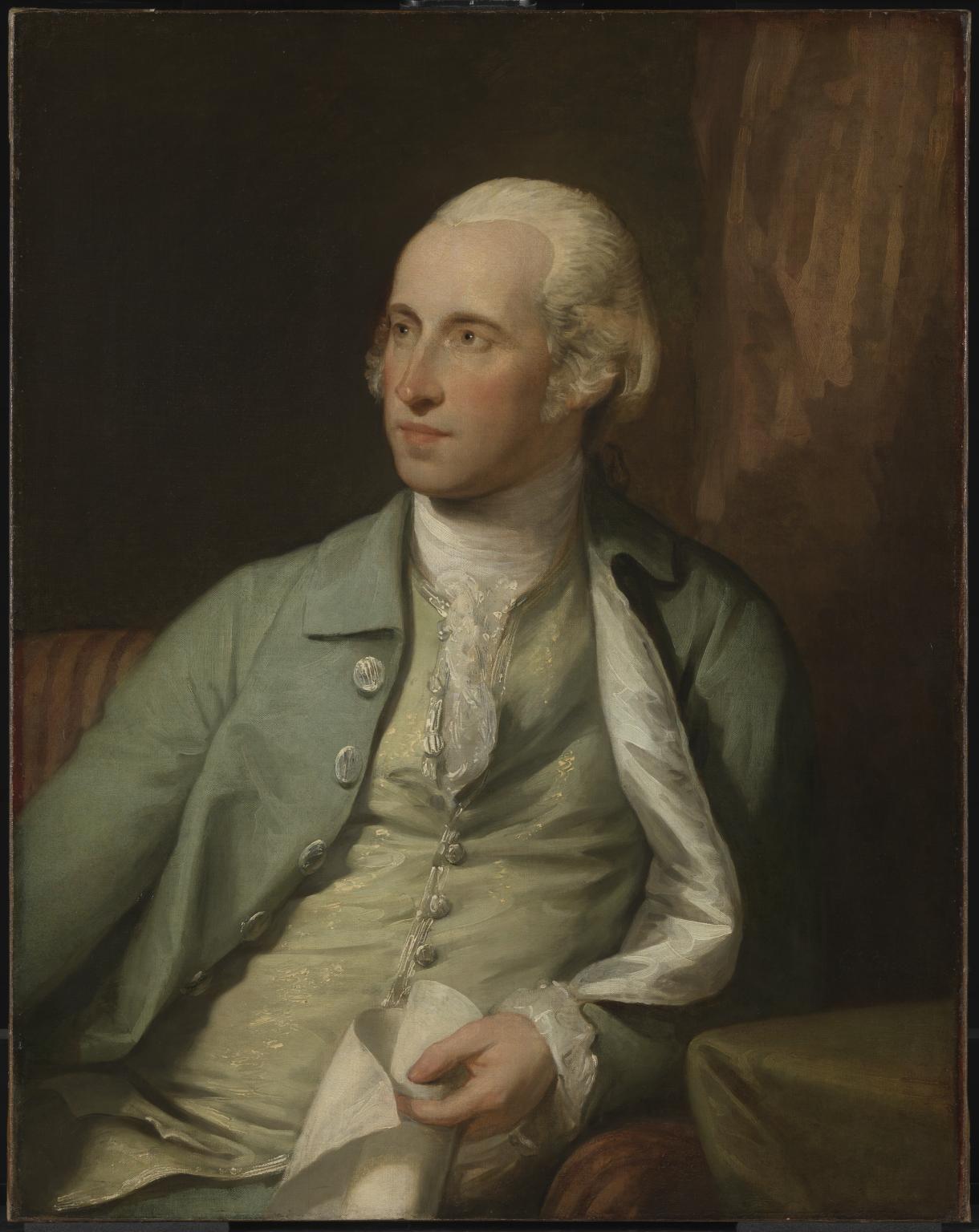
Gilbert Stuart, Benjamin West, P.R.A. ?exhibited 1781
The American-born painter Benjamin West was one of the most successful artists of his generation. He was one of King George III’s favourite artists, which gave him privileges and wealth that made him the envy of his contemporaries. This polished portrait suggests an affluent and genteel personality.
West’s studio in London was a gathering place for Americans studying art in Europe. Many of these returned home to pursue careers in their newly independent homeland. This portrait is by one of West’s most successful American students, Gilbert Stuart.
Gallery label, August 2004
2/30
artworks in 1760–1830
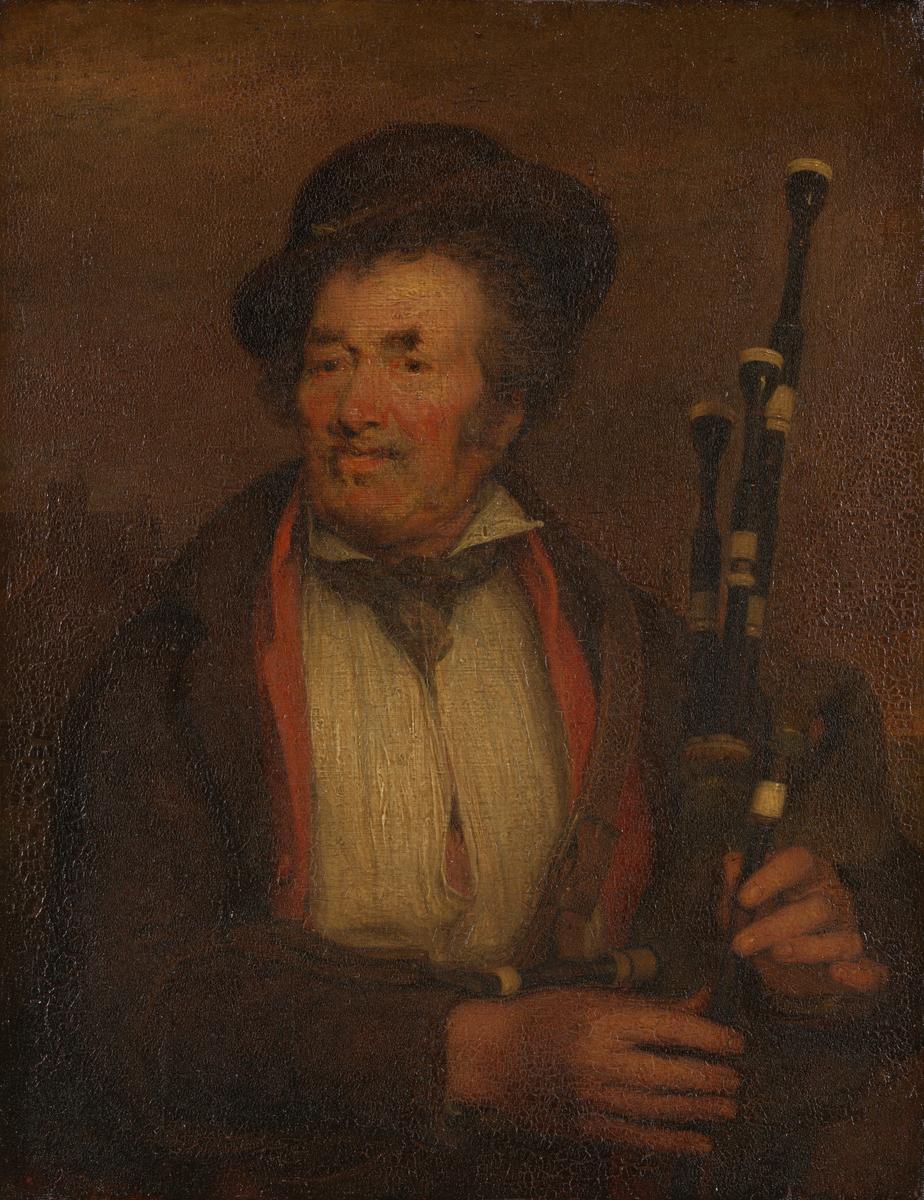
Sir David Wilkie, The Bag-Piper 1813, exhibited 1813
Wilkie exhibited this intimate portrait in 1813, when his reputation as a painter of character was already well-established. As a Scottish artist, Wilkie was keen to elevate the status of his national school. Here, however, he seems to draw on stereotypes, showing his character with a red nose and cheeks, auburn hair and thick eyebrows. These elements evoke the wildness associated with the Scots by many 19th-century English viewers. While Wilkie’s picture may appear to be taken from life, it also answered a demand for romanticised images of Scotland.
Gallery label, March 2011
3/30
artworks in 1760–1830
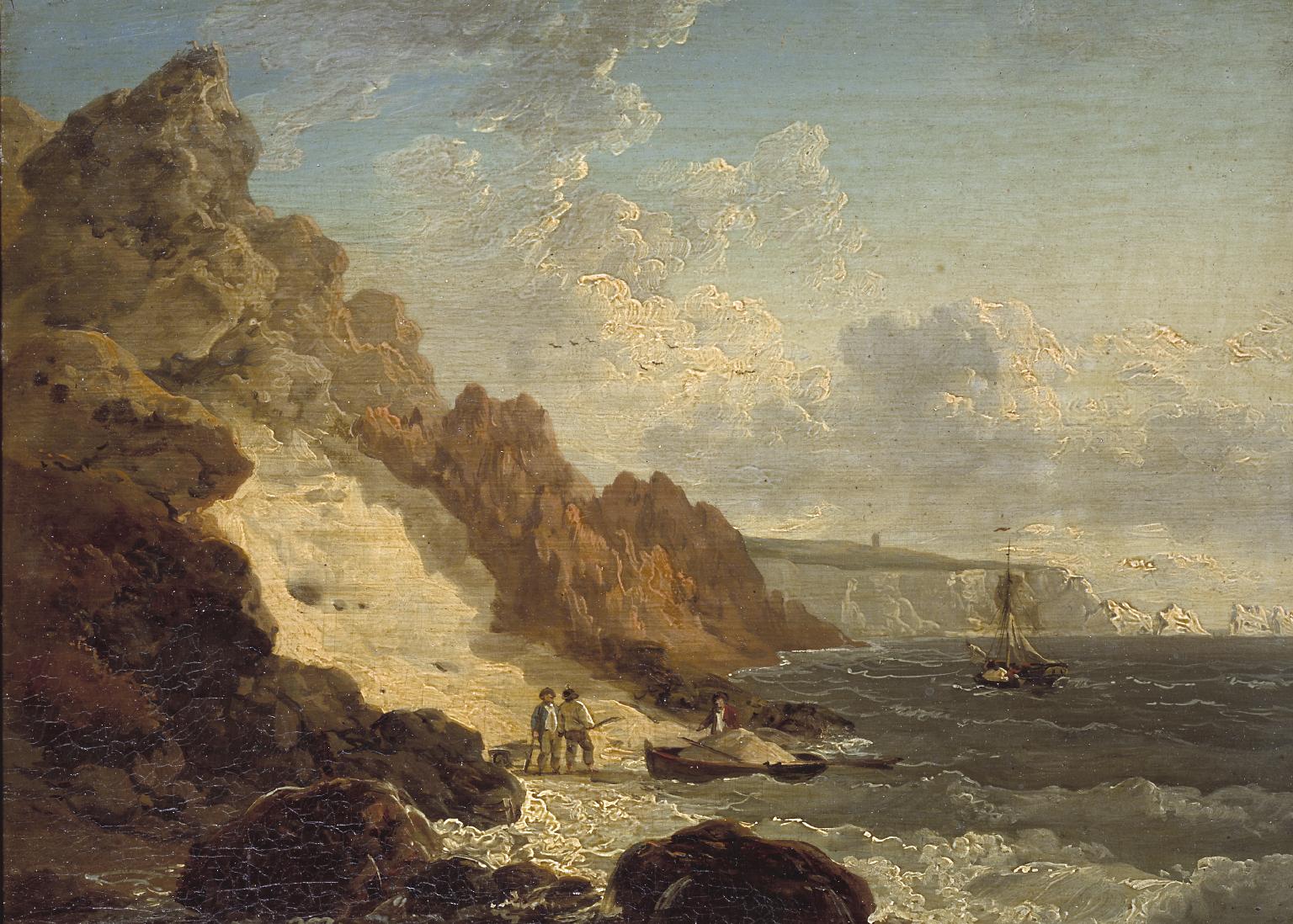
Julius Caesar Ibbetson, Sand Quarry at Alum Bay ?exhibited 1792
4/30
artworks in 1760–1830
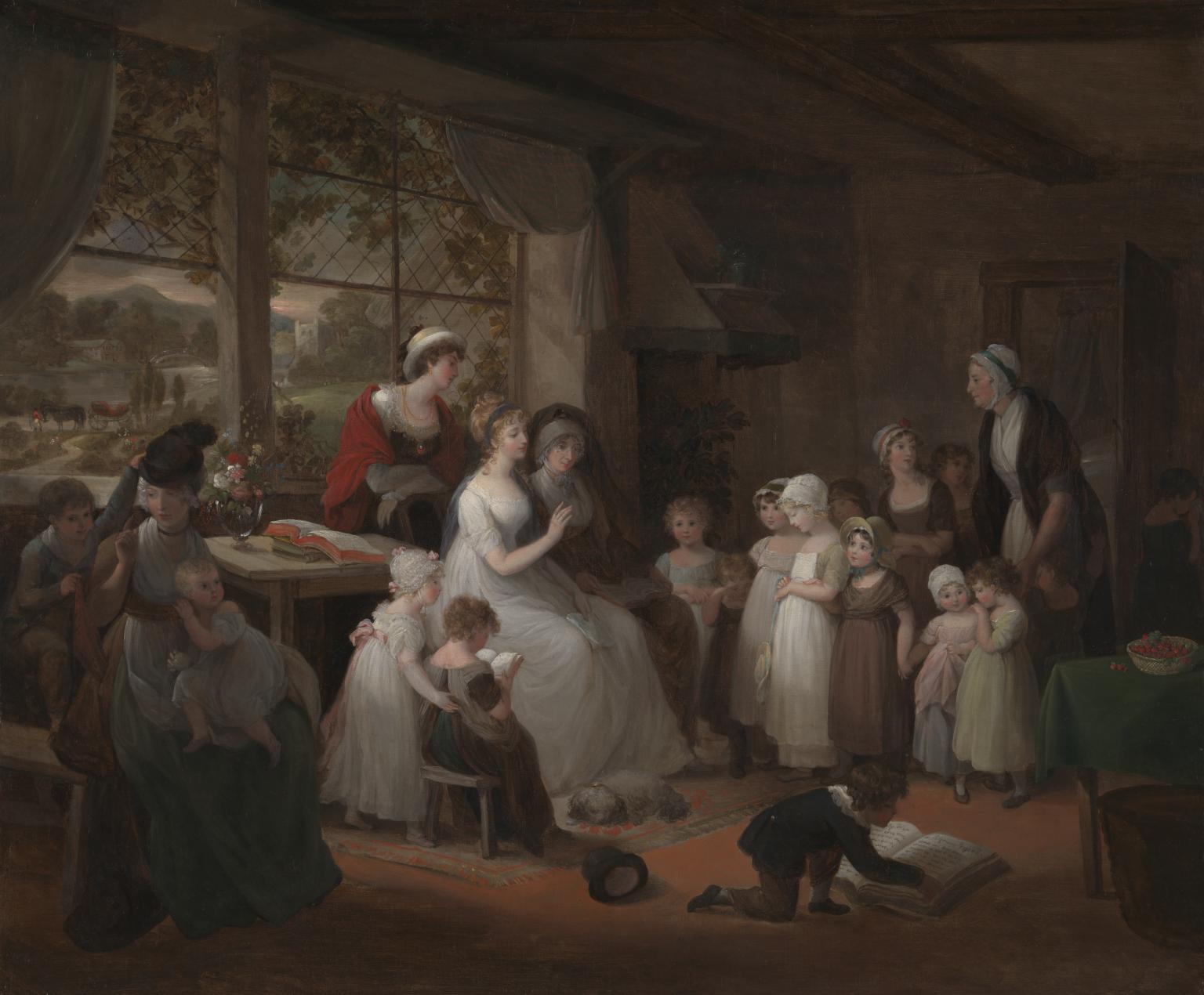
Maria Spilsbury, The Schoolmistress c.1803
5/30
artworks in 1760–1830
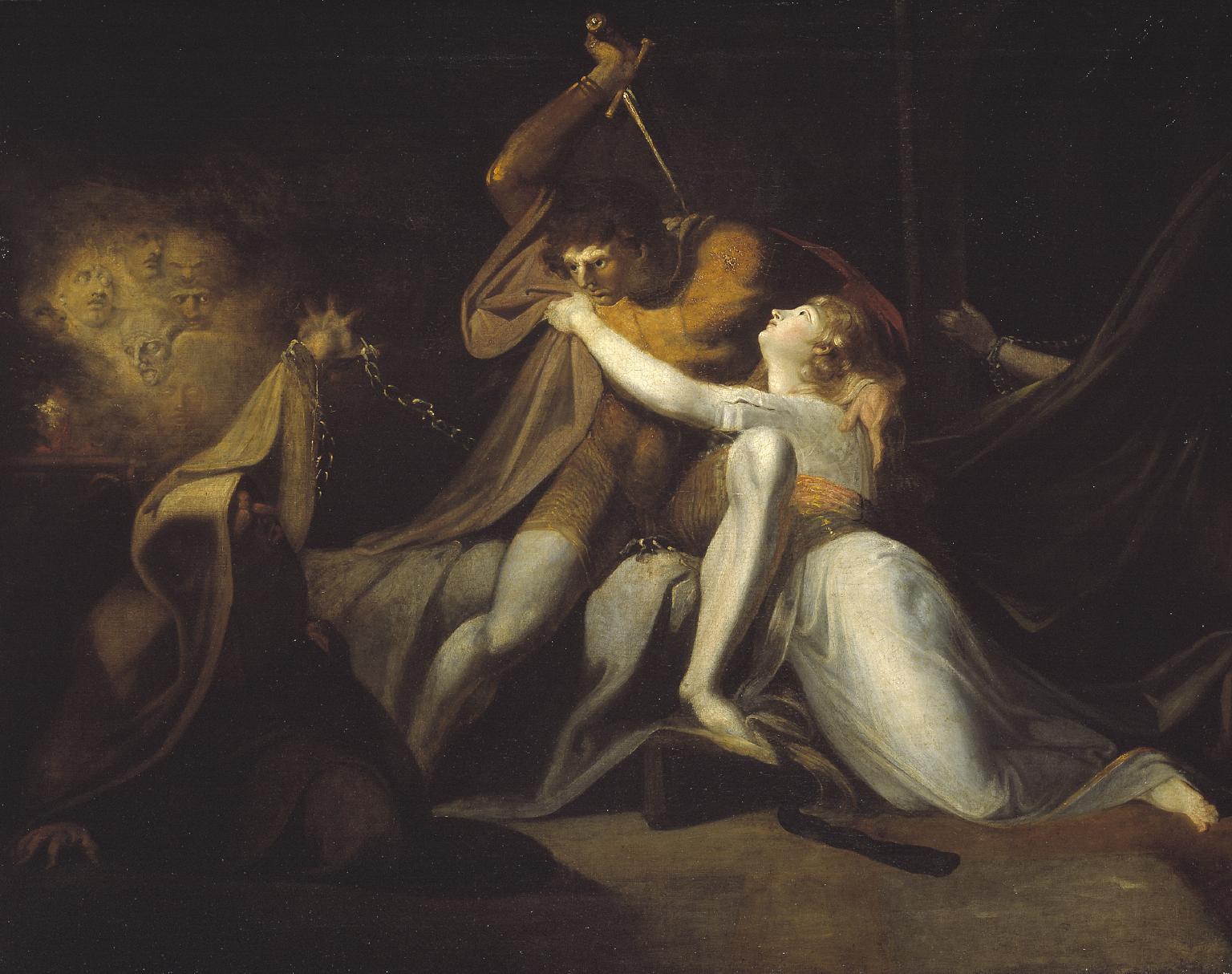
Henry Fuseli, Percival Delivering Belisane from the Enchantment of Urma exhibited 1783
Conventionally, history paintings were based on a literary or historical source familiar to educated viewers. The artist’s role was to select from the story a crucially significant moment that would convey a sense of nobility and moral certainty.
The success of this strategy of course depended on the viewer knowing the story, and so knowing what would happen next. Fuseli, however, admitted that he invented the saga of Percival and Belisane shown here. His paintings tended to emphasis spectacle and sensation rather then the noble themes and moral lessons which Reynolds’s view of the ‘great style’ demanded.
Gallery label, September 2004
6/30
artworks in 1760–1830
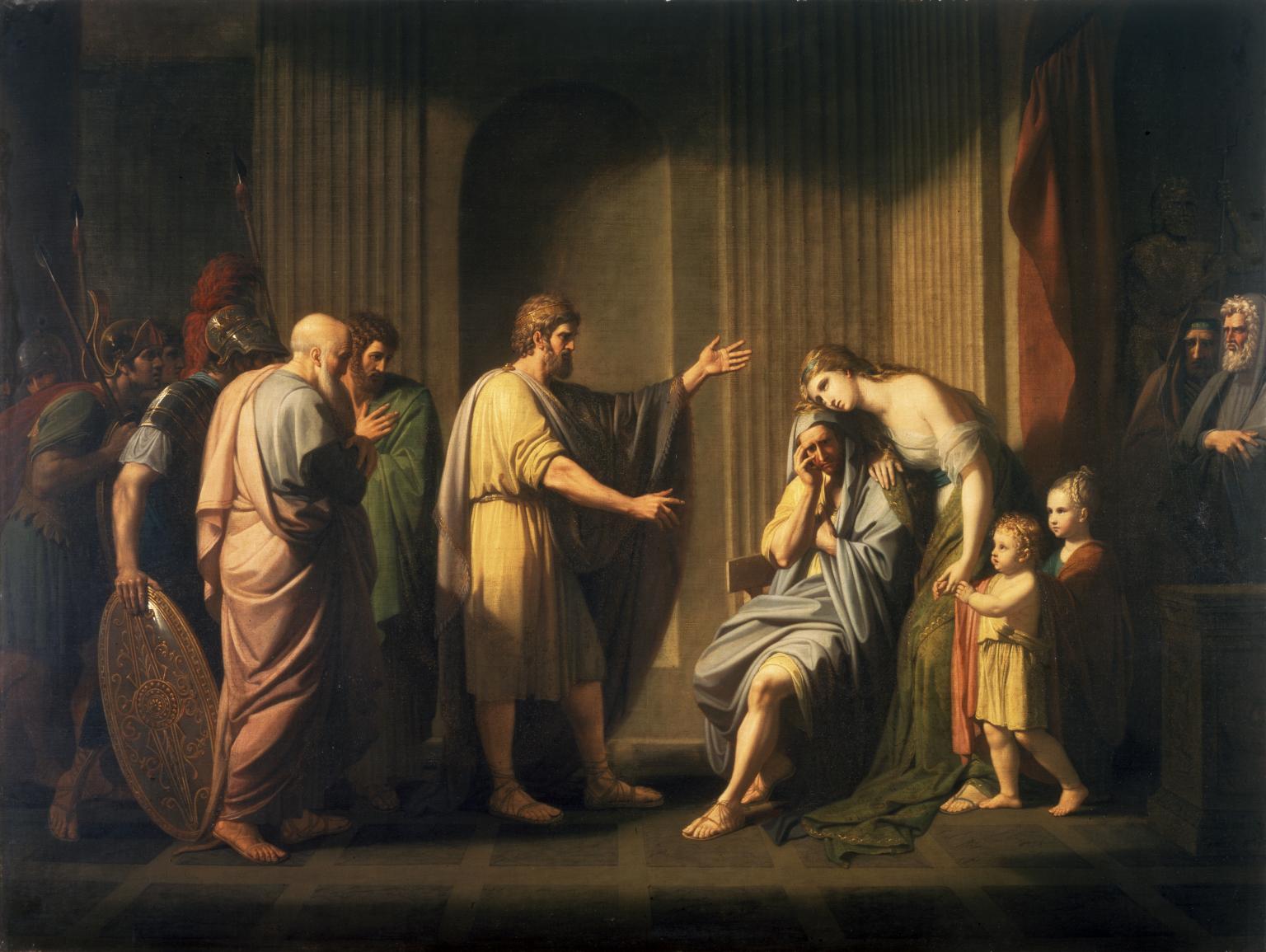
Benjamin West, Cleombrotus Ordered into Banishment by Leonidas II, King of Sparta 1768
Benjamin West showed this painting at the second exhibition of the newly formed Royal Academy. After several years in Italy, West had established himself in London as the leading painter of subjects from classical history. His example, and the Academy’s teaching, encouraged numerous young British artists to study in Italy.
His subject is an incident from ancient Greek history. Leonidas, king of Sparta, was usurped by his son-in-law, Cleombrutus. When Leonidas returns looking for revenge, his daughter pleads for her husband’s life. Leonidas is moved by her tears, and commutes Cleombrutus’s death sentence to banishment.
Gallery label, September 2004
7/30
artworks in 1760–1830
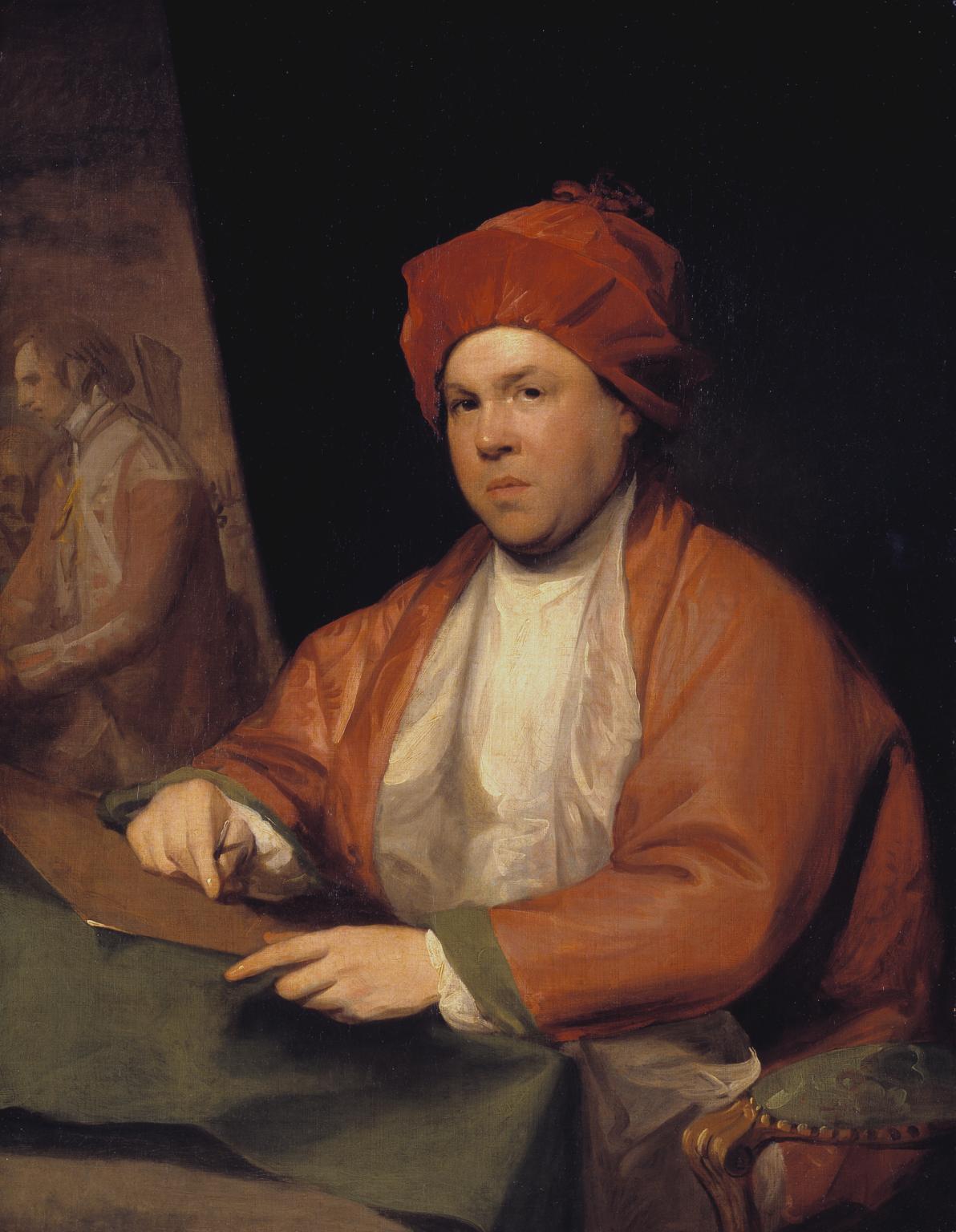
Gilbert Stuart, William Woollett the Engraver exhibited 1783
William Woollett was one of the most celebrated engravers of his day. He is shown here about to start work on his engraving of Benjamin West’s painting The Death of General Wolfe. Part of the picture can be seen in the background on the left. Although not a true representation of how an engraver would work, this portrait does show Woollett holding the copper plate on which the painting was to be reproduced. In his right hand is a pointed steel burin, or graver. It was primarily through the distribution of engravings that the image of Wolfe achieved iconic status.
Gallery label, February 2016
8/30
artworks in 1760–1830
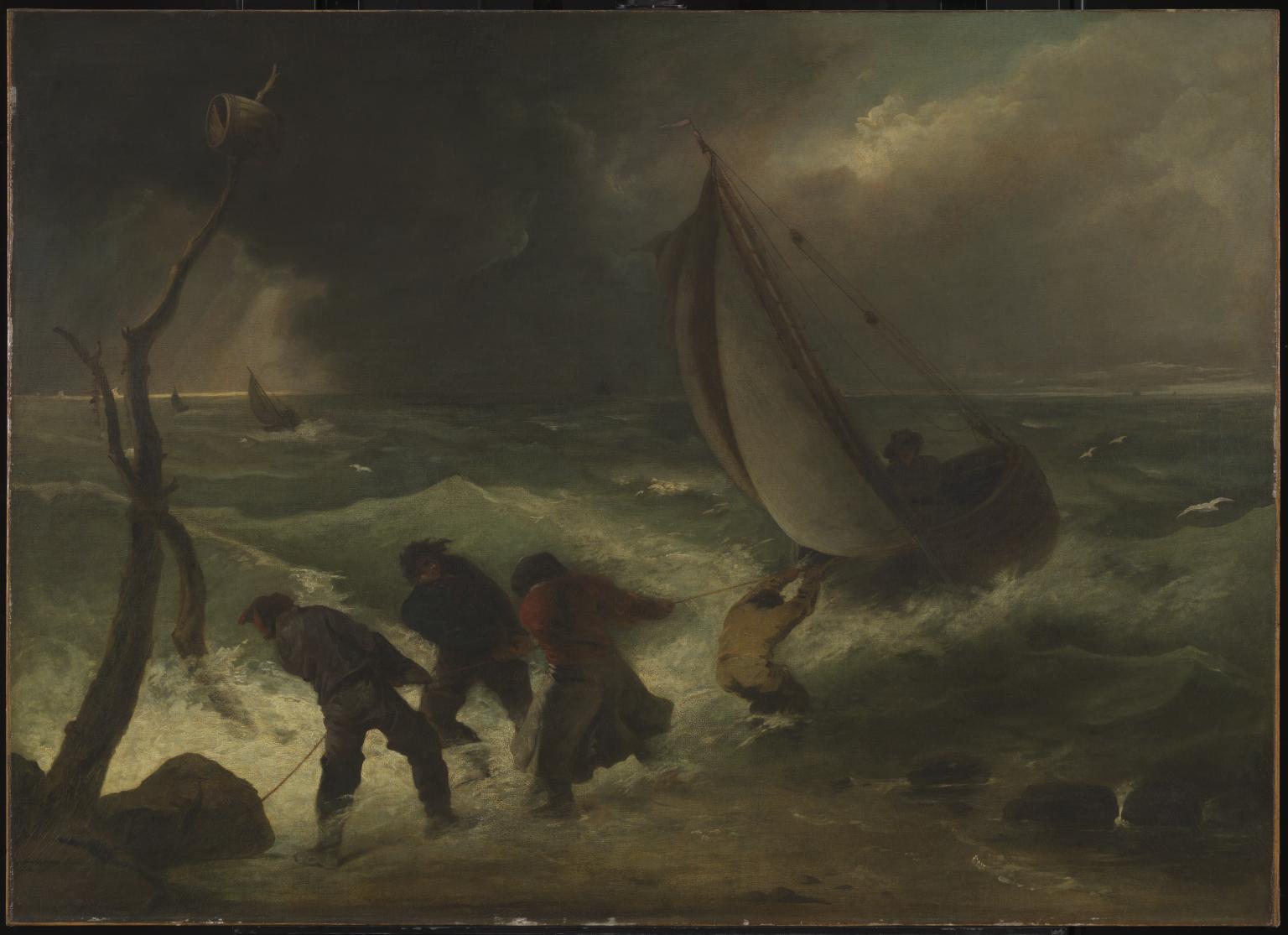
John Hoppner, A Gale of Wind c.1794
Hoppner originally intended to become a landscape painter. However, this seascape, shown at Royal Academy in 1795, is the only work other than portraits he is known to have exhibited.
Attention is focused on the large figures in the foreground as they battle against the raging wind and the overwhelming forces of nature. The scene is set just off St Catherine’s Point on the Isle of Wight, known for its treacherous waters.
Gallery label, September 2004
9/30
artworks in 1760–1830
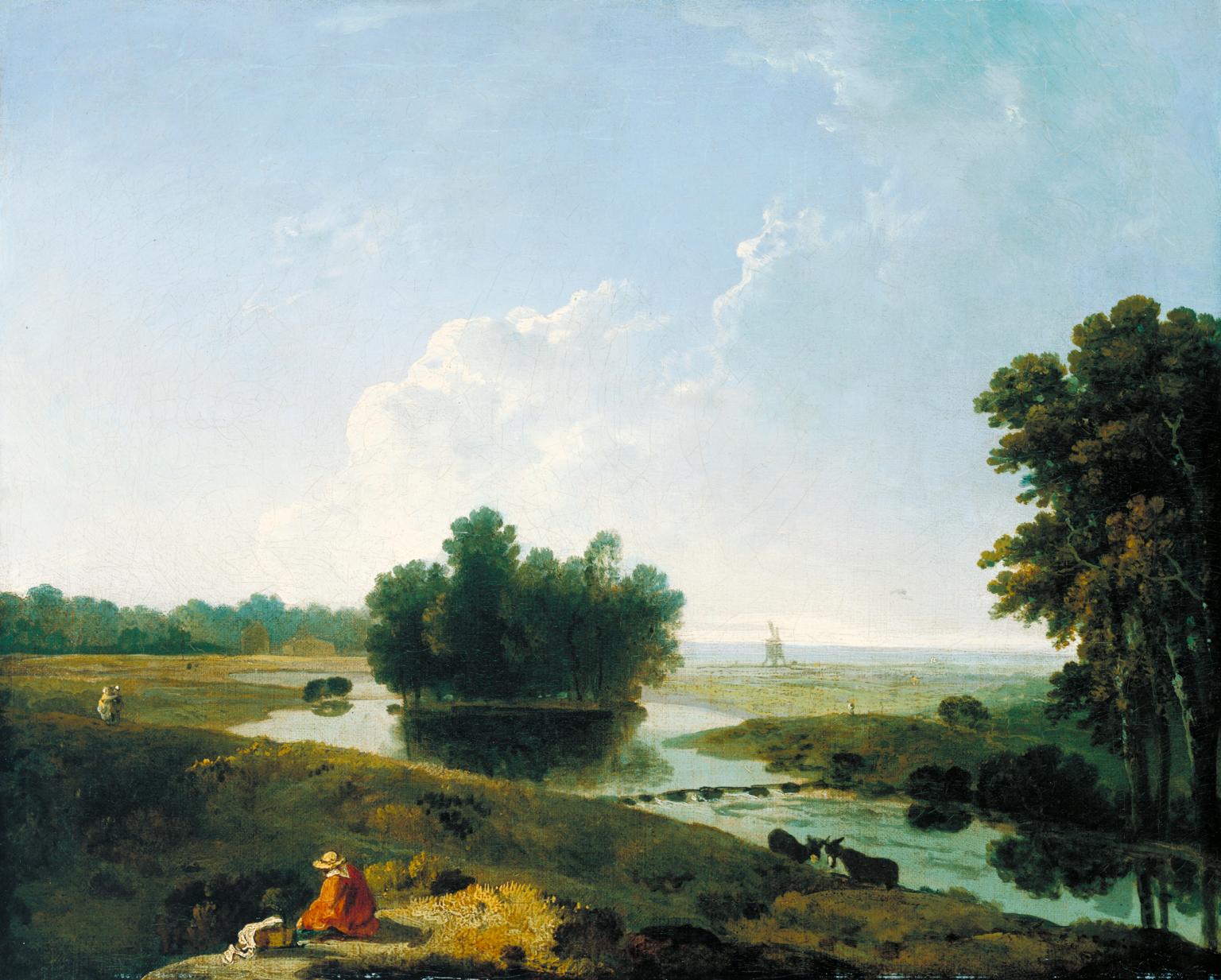
Richard Wilson, On Hounslow Heath ?exhibited 1770
The view shows the watermeadows beside the River Crane. This area of Hounslow Heath was not known for its beauty or cultural significance. Instead, the attraction of this picture lies in the beauty of the sky and the reflections in the water. In this it is an example of a new type of landscape view, designed to bring a vision of a rural idyll into the city dweller's home. The picture was commissioned by Tom Davies, who was a Bloomsbury bookseller, and one of a growing number of middle-class urban patrons of English landscape subjects.
Gallery label, September 2004
10/30
artworks in 1760–1830
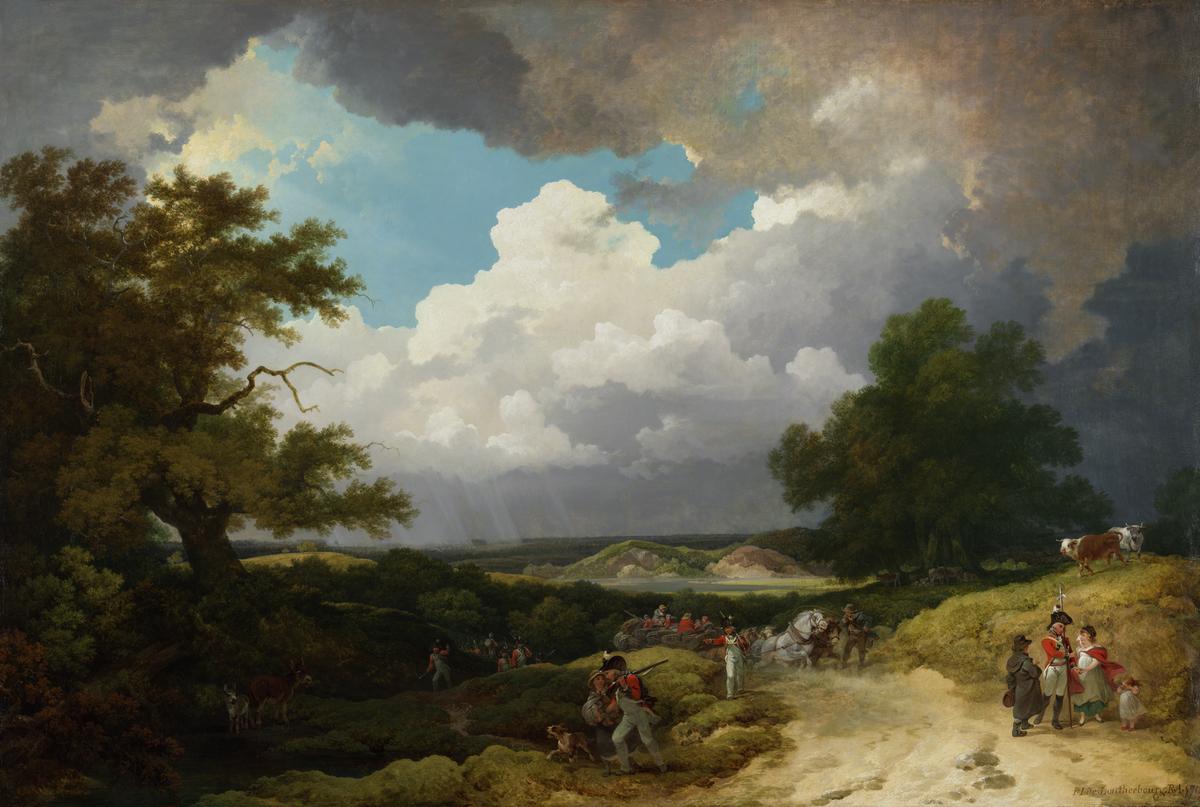
Philip James De Loutherbourg, A Distant Hail-Storm Coming On, and the March of Soldiers with their Baggage 1799
Loutherbourg’s picture is filled with foreboding. It was painted shortly after the French revolution and at the beginning of the wars with revolutionary France and its allies. The landscape is stormy and overcast, and peopled by soldiers. This reflects how the nation was becoming militarised and placed on a war footing, with military exercises and recruitment and conscription reaching even remote areas.
Gallery label, May 2007
11/30
artworks in 1760–1830
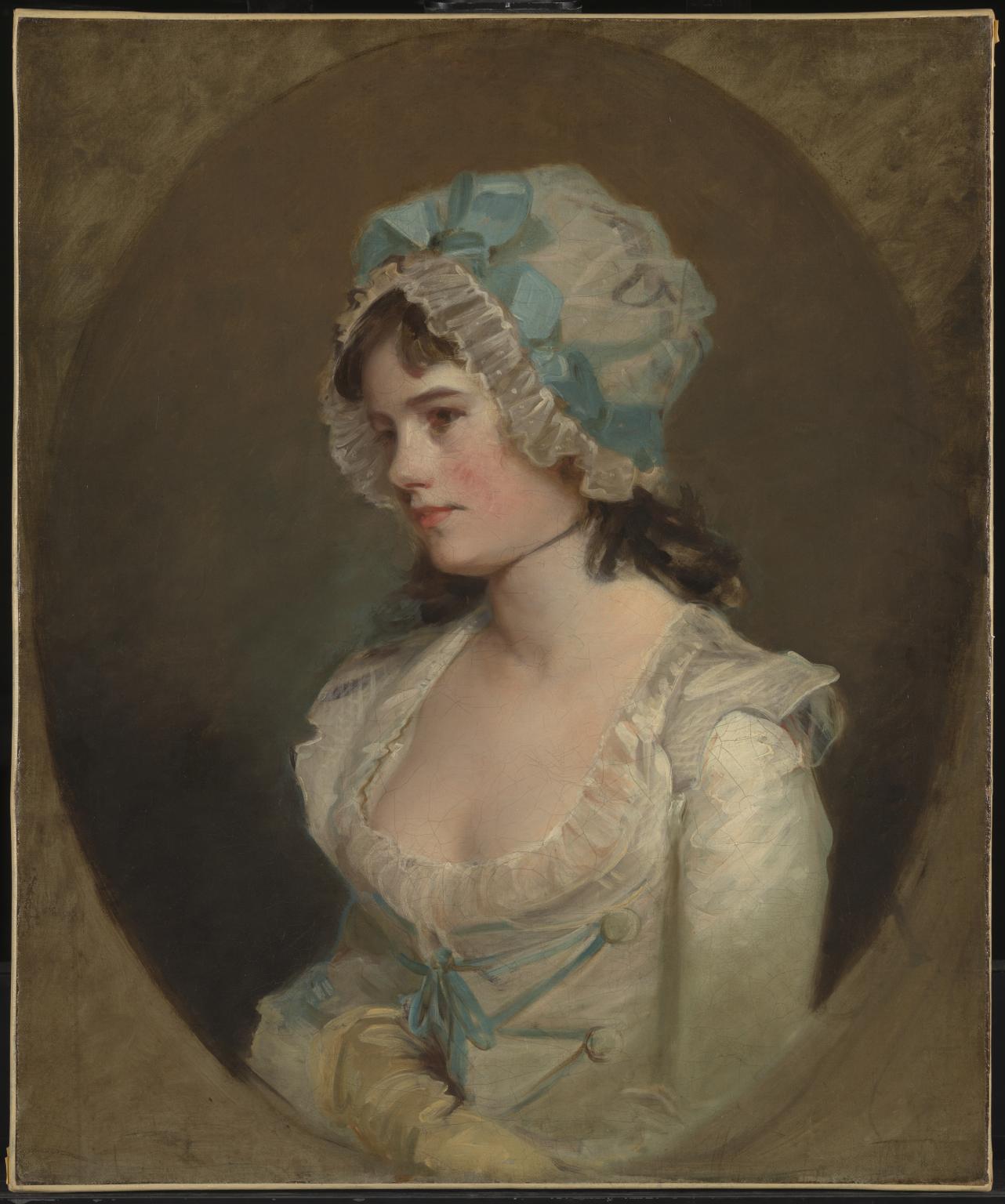
John Hoppner, Mrs Williams c.1790
12/30
artworks in 1760–1830
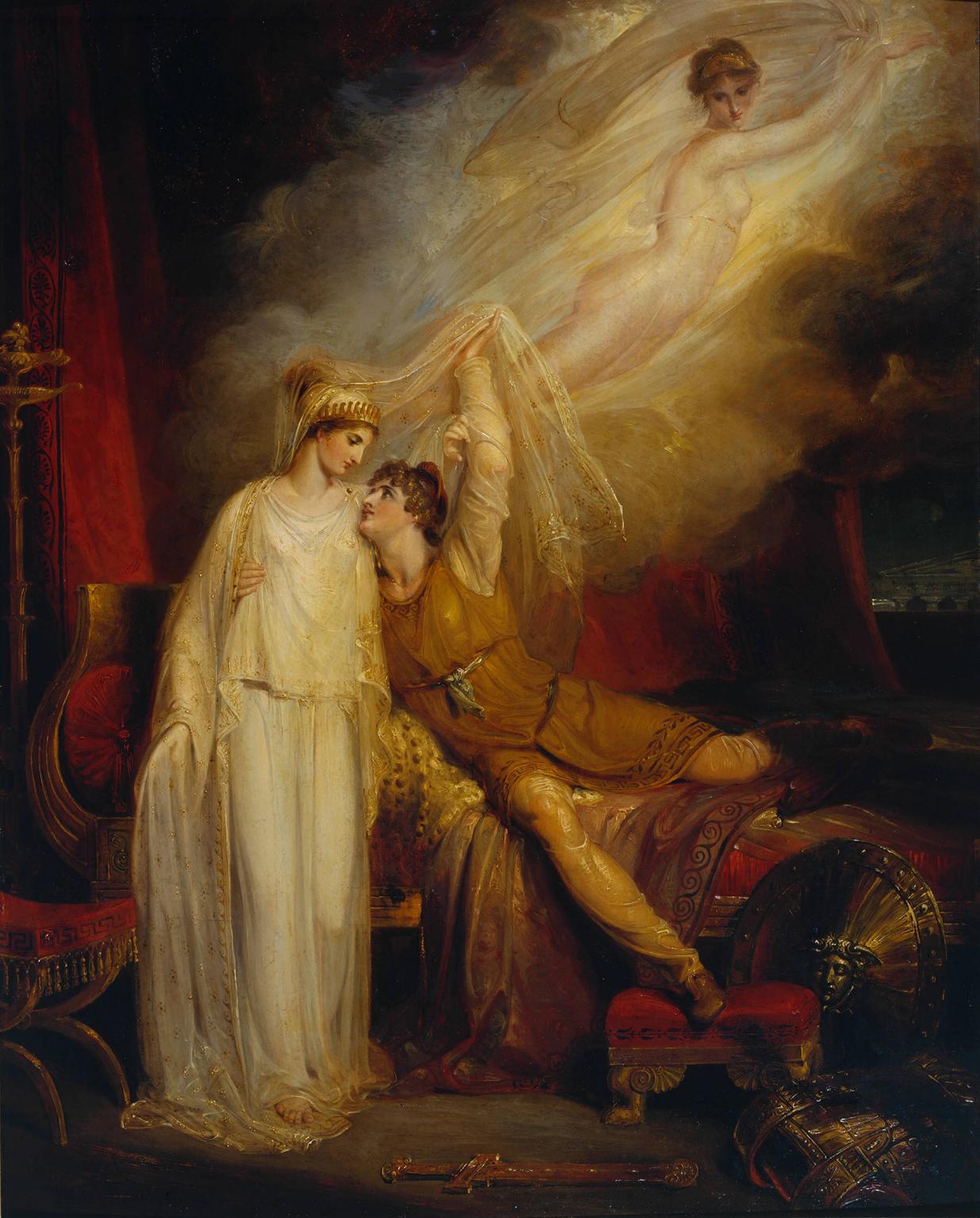
Richard Westall, The Reconciliation of Helen and Paris after his Defeat by Menelaus exhibited 1805
In Greek legend, the beautiful Helen was the wife of Menelaus, king of Sparta. Her affair with the Trojan prince, Paris, led to the Trojan War.Westall painted this picture for Thomas Hope, a fabulously wealthy collector of the antique and of selected contemporary art. Hope’s taste ran from strict neo-classicism to Romantic exoticism. The rooms of his London house were furnished and decorated to reflect various regions of the ancient world – Egypt and India as well as Greece and Rome. Westall modelled the figure of Helen on a Greek statue in Hope’s collection.
Gallery label, May 2007
13/30
artworks in 1760–1830
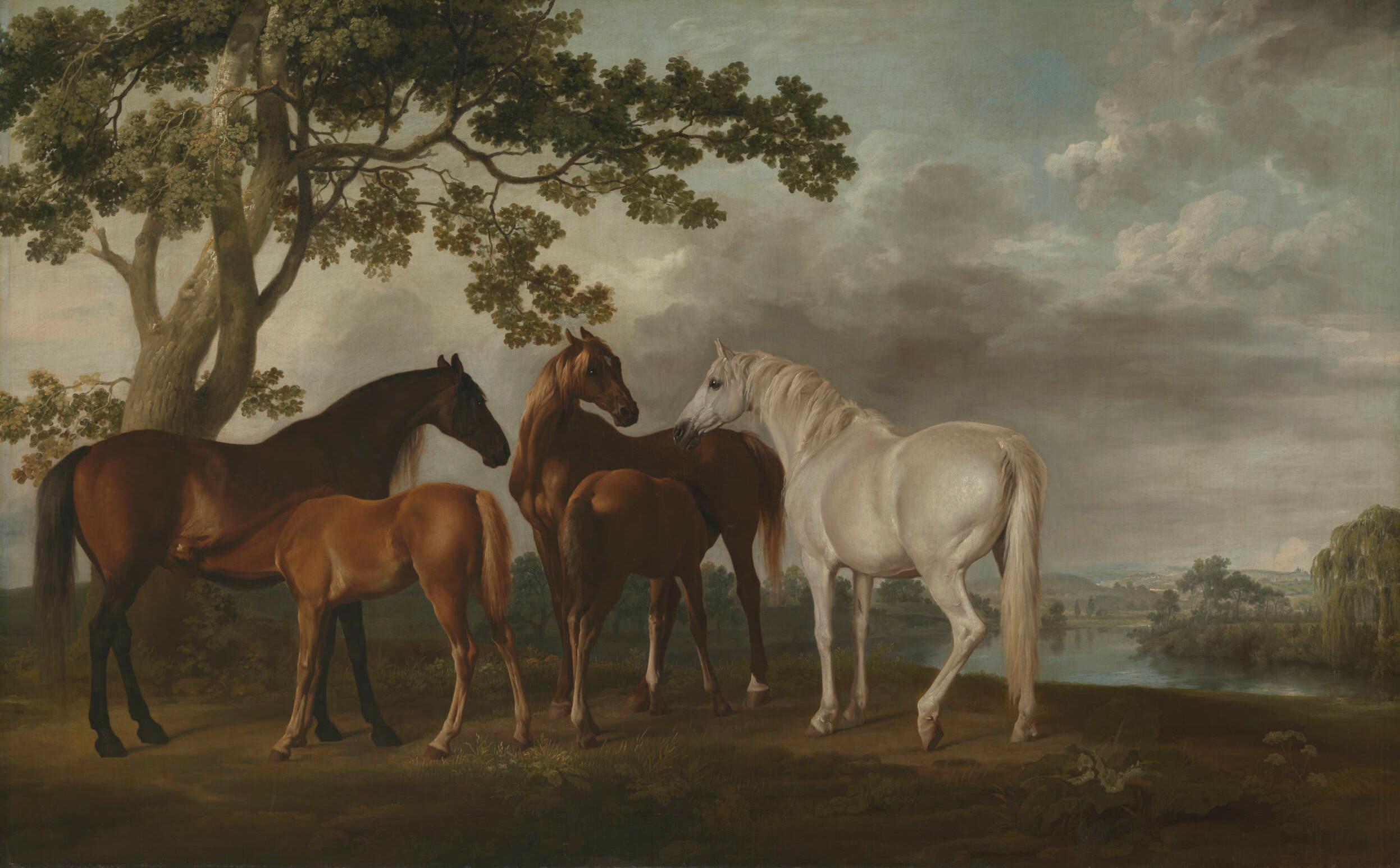
George Stubbs, Mares and Foals in a River Landscape c.1763–8
This painting seems to have been used as an ‘overdoor’, hung with two other pictures by Stubbs above the doors in the dining room of George Brodrick, 3rd Viscount Midleton, MP (1730–65). Reflecting the ornamental use to which this painting was to be put, it seems that Stubbs, the premier animal painter of his day, did not set out to be especially original. The figures of the horses are the same as those appearing in another painting, a commission for Lord Rockingham representing specific horses owned by him, although the colour of one has been changed from brown to grey.
Gallery label, February 2016
14/30
artworks in 1760–1830
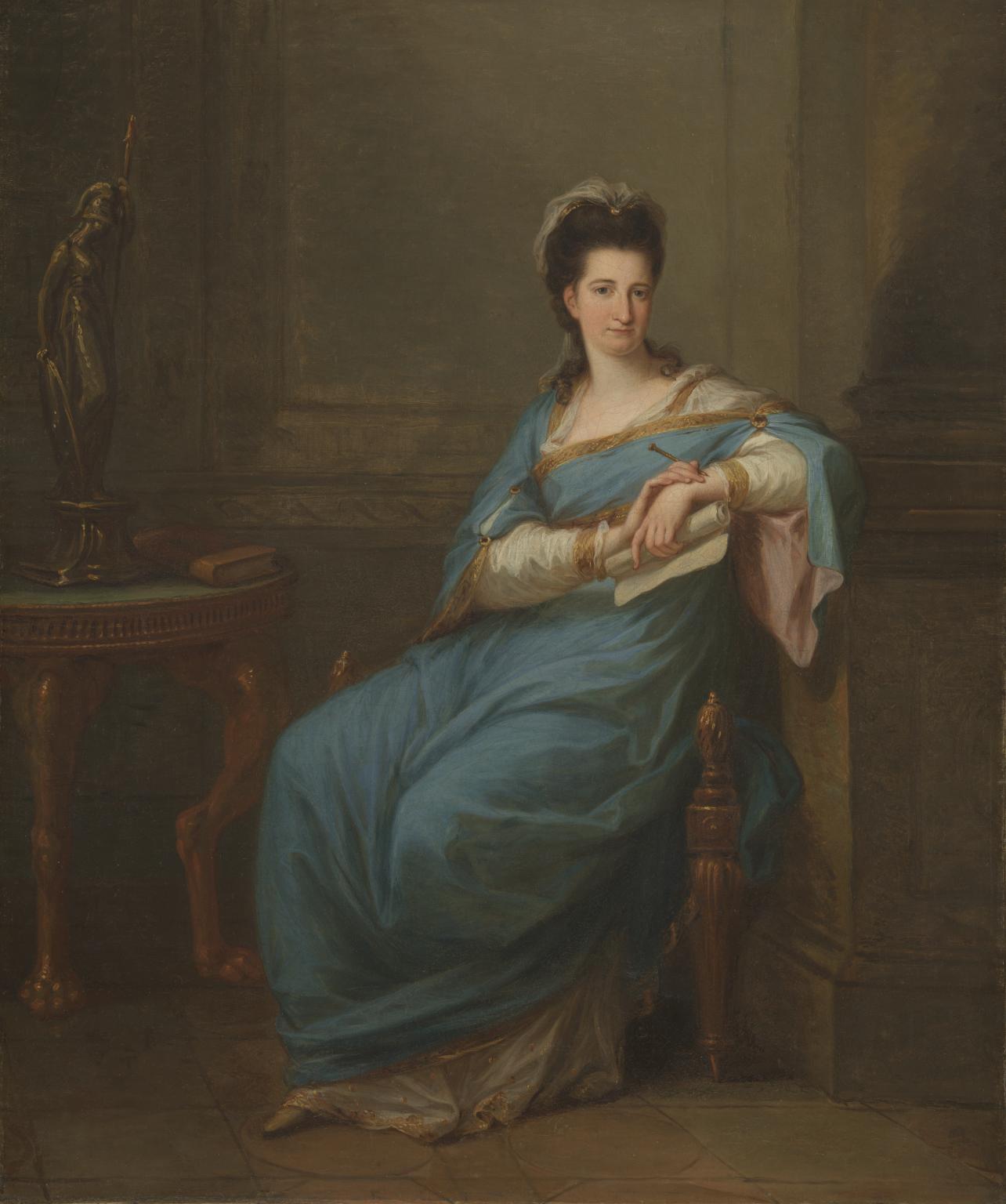
Angelica Kauffman, Portrait of a Lady c.1775
The unknown woman in this portrait is seated in classical robes by a statue of Minerva, the goddess of wisdom. The book upon the table and the writing materials in her hand suggest that she is a writer. Angelica Kauffmann’s interest in classical portraiture and history painting was nurtured during her time in Italy during the 1760s. Kauffmann, who was Swiss by birth, settled in England in 1766, remaining there until 1781, when she departed once more for Italy. In England Kauffmann specialised in decorative history painting and small scale portraits of female subjects, such as the one shown here.
Gallery label, February 2016
15/30
artworks in 1760–1830
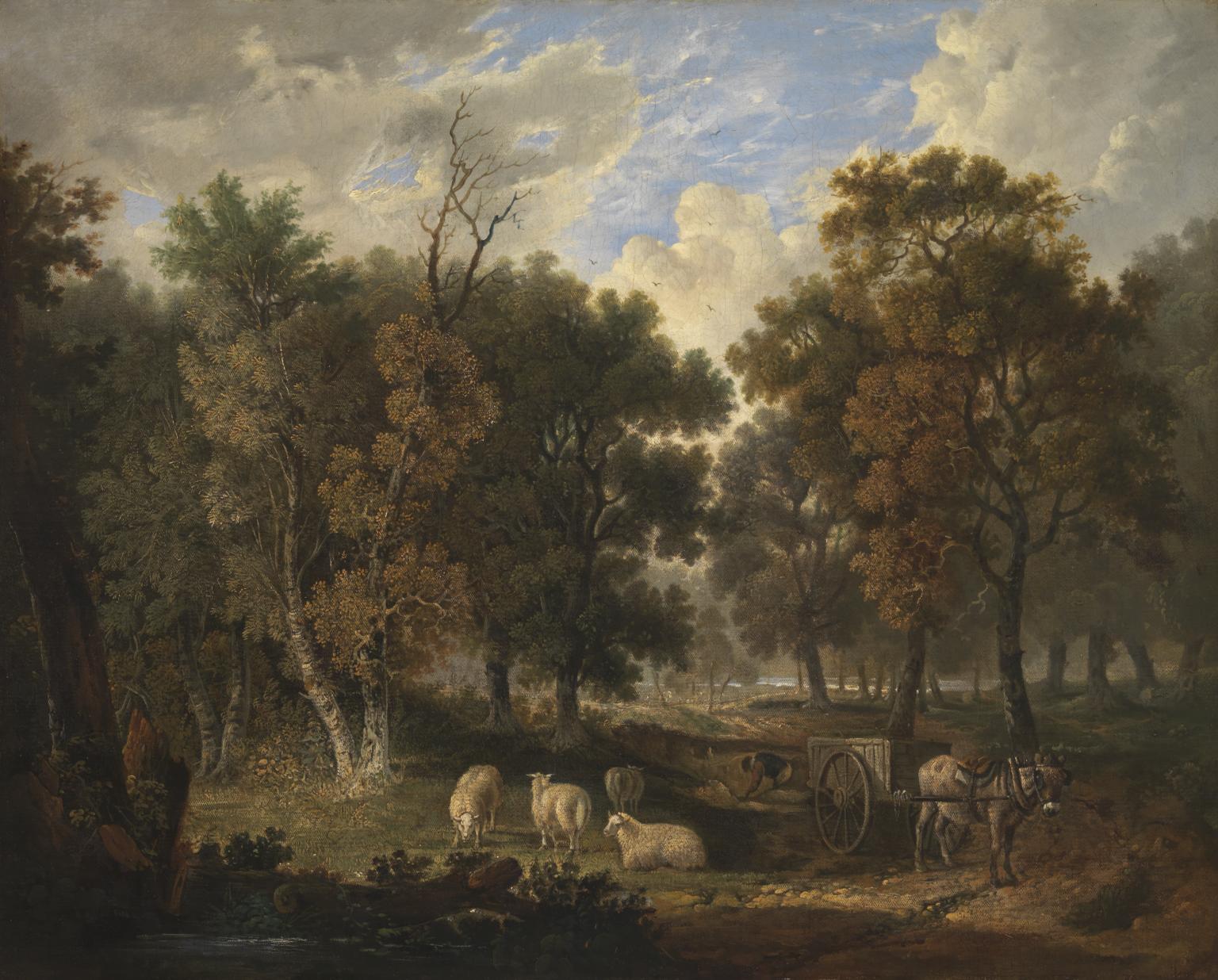
Robert Ladbrooke, Wood Scene exhibited 1806
16/30
artworks in 1760–1830
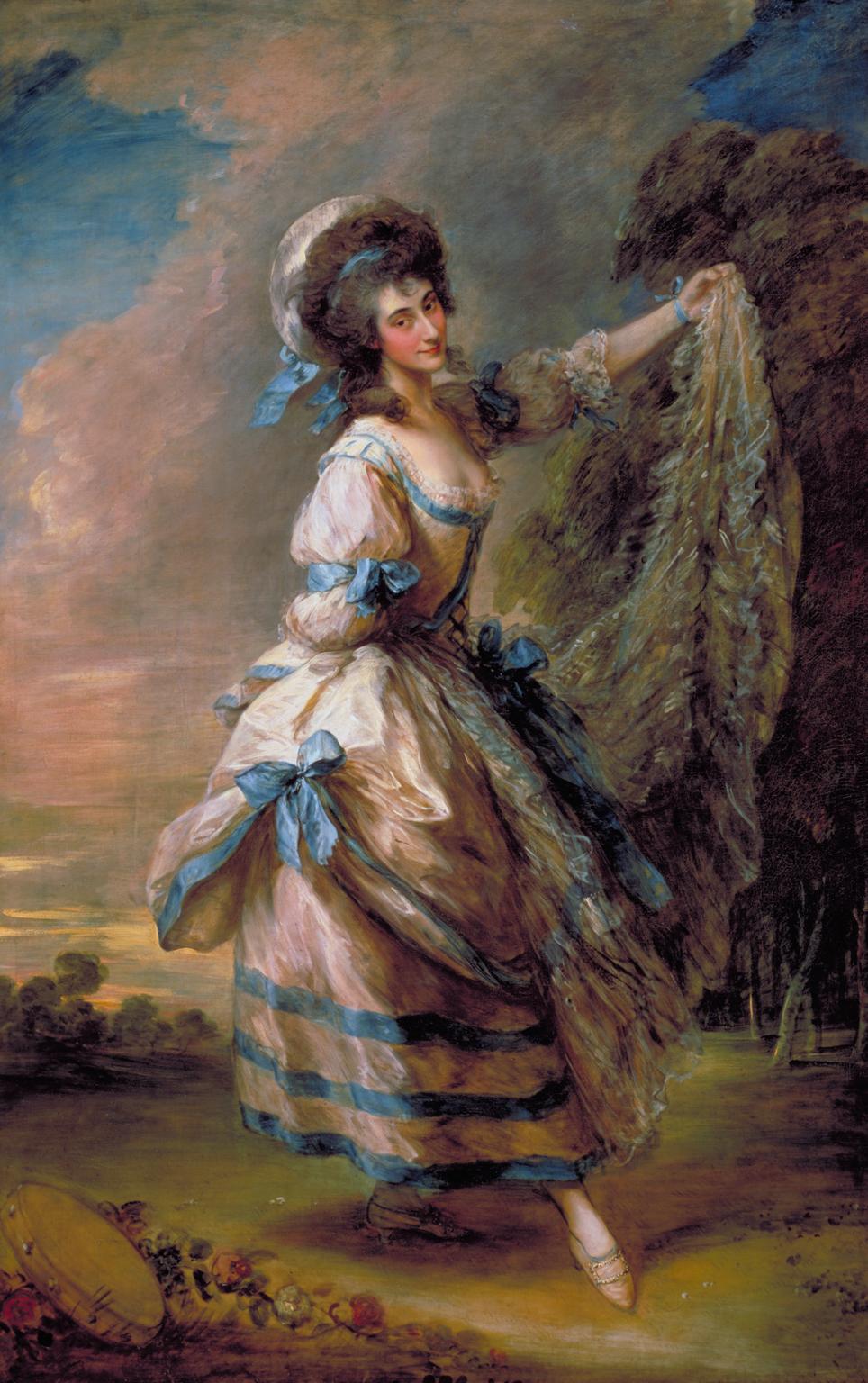
Thomas Gainsborough, Giovanna Baccelli exhibited 1782
This portrait shows the famous Italian dancer Giovanna Zanerini, known on the stage as Baccelli, at the height of her career. Her elaborate costume seems to be adapted from the ballet Les Amants Surpris in which she had recently taken London by storm. Baccelli was the mistress of John Sackville, 3rd Duke of Dorset who commissioned the painting. The rapid brushwork, translucent paint and shimmering light effects are typical of Gainsborough’s style at this time. When the portrait was first exhibited, it was chiefly praised as an excellent likeness; ‘as the Original, light airy and elegant’.
Gallery label, February 2016
17/30
artworks in 1760–1830
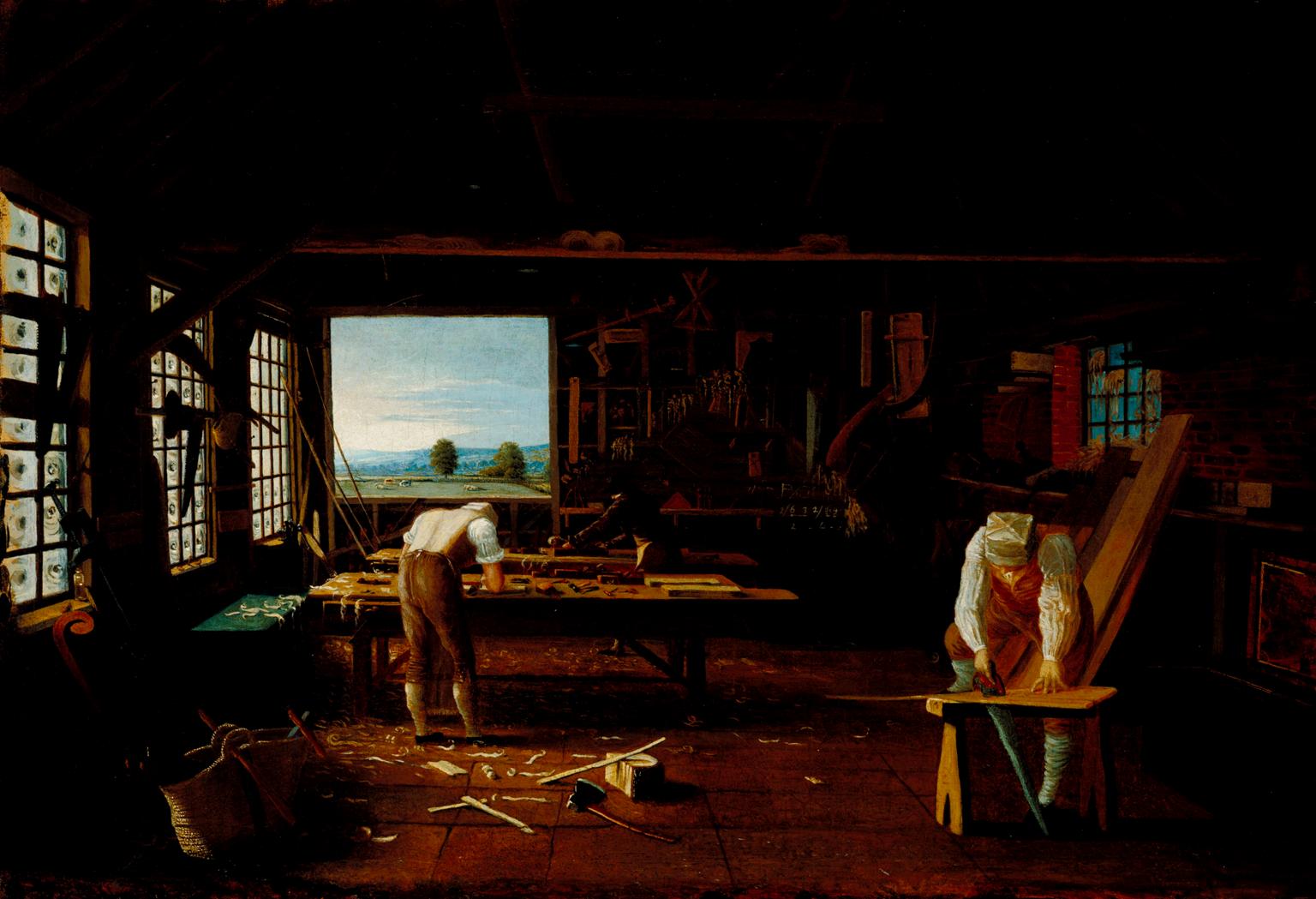
John Hill, Interior of the Carpenter’s Shop at Forty Hill, Enfield ?exhibited 1813
18/30
artworks in 1760–1830
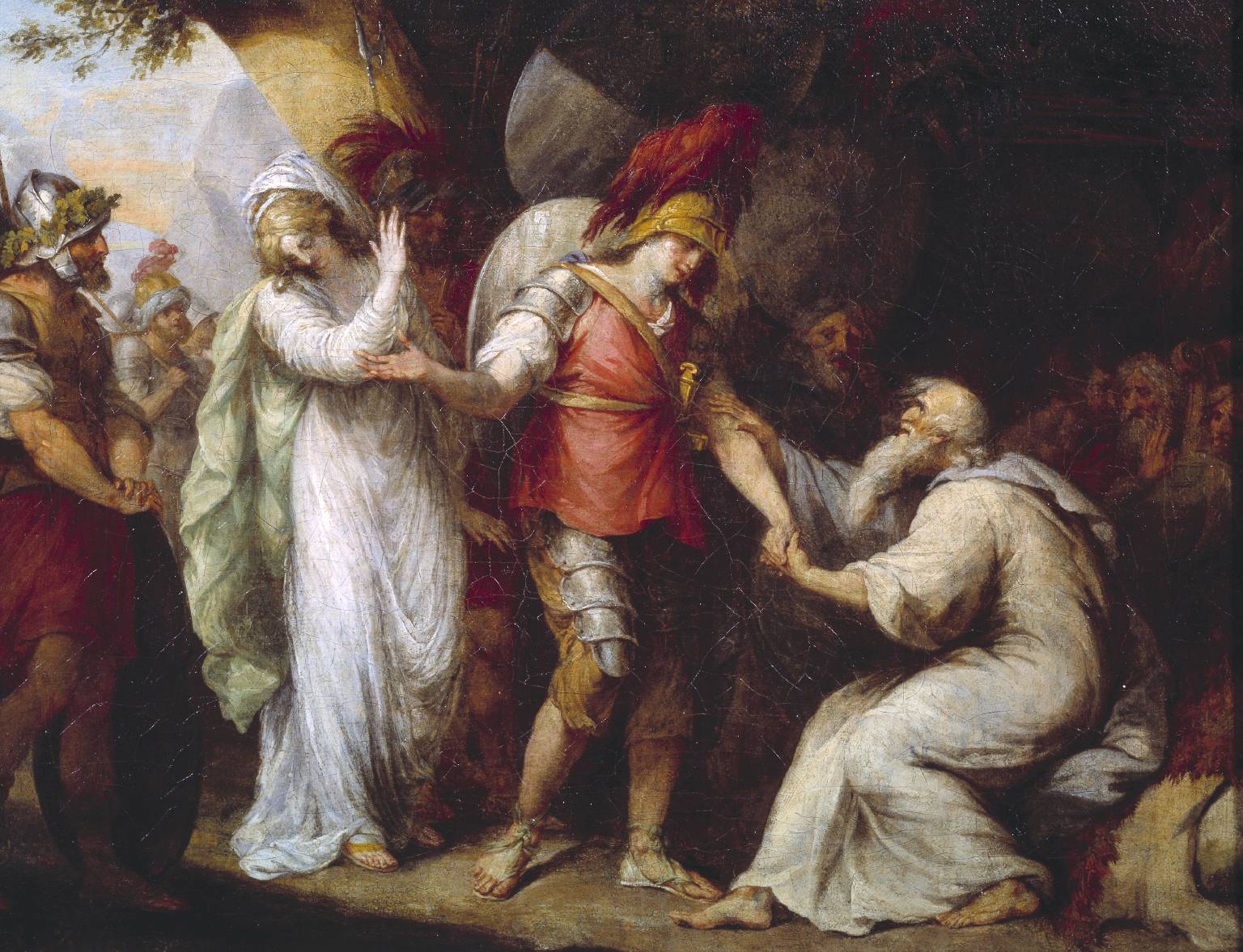
Charles Reuben Ryley, Oscar Bringing Back Annir’s Daughter 1785
The strength of Scottish identity lay not only in the figure of the Highlander, but also in a sense of Scotland’s ancient legendary past, enshrined in the potent myth of Ossian.
In the mid-eighteenth century, the poet James Macpherson had produced what he claimed was a faithful translation of an epic of primeval Scotland by an ancient Celtic bard named Ossian. In fact Macpherson had heavily edited fragments of Gaelic poems and added much of his own writing. His poems nevertheless provided sentimental and dramatic scenes for many late-eighteenth-century artists including English painters like Charles Ryley.
Gallery label, July 2004
19/30
artworks in 1760–1830
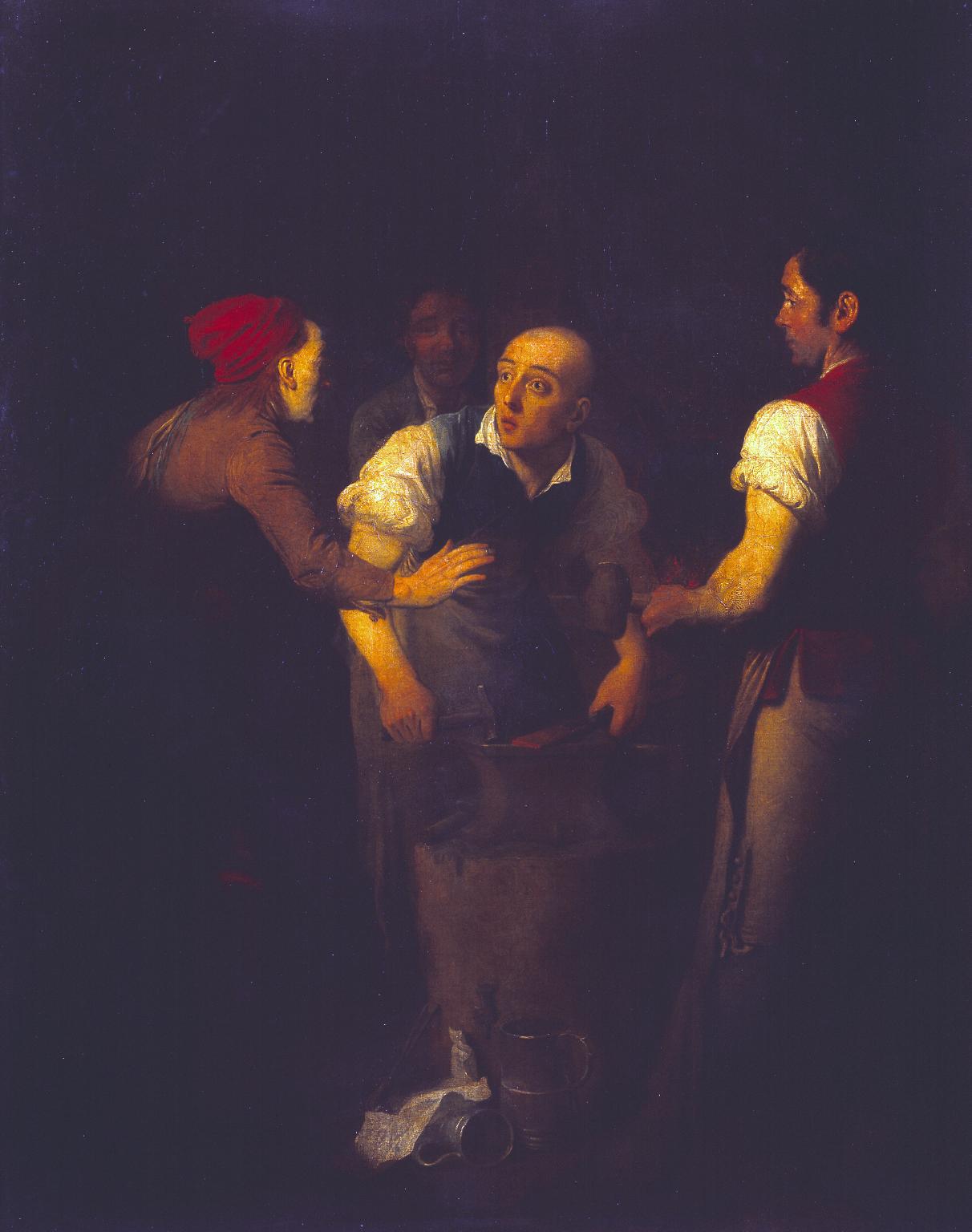
Edward Penny, The Gossiping Blacksmith exhibited 1769
20/30
artworks in 1760–1830

Francesco Zuccarelli, A Landscape with the Story of Cadmus Killing the Dragon exhibited 1765
This painting illustrates the story of Cadmus, founder of the ancient city of Thebes, as told in Ovid’s Metamorphoses. Cadmus is slaying the dragon that has killed his companions. They have died trying to collect spring water from the dragon’s cave, not knowing that it is sacred to the god Mars. Cadmus is protected by a lion-skin and armed with a javelin. The Italian painter Zuccarelli left Venice for London in 1752, his mythological landscapes popular with British patrons. In 1768 he was commissioned to produce works for George III, and was a founding member of The Royal Academy.
Gallery label, February 2016
21/30
artworks in 1760–1830
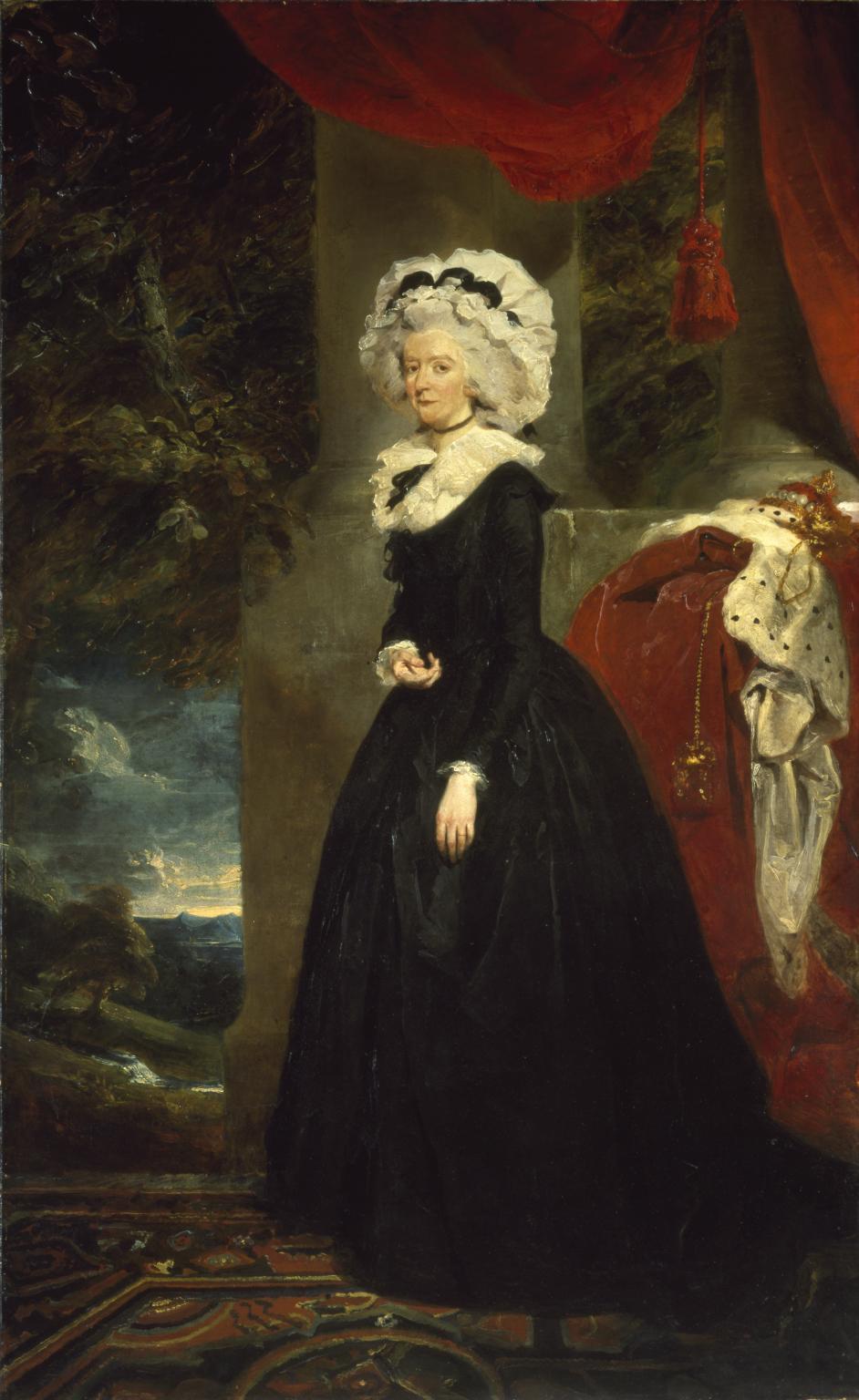
Sir Thomas Lawrence, Philadelphia Hannah, 1st Viscountess Cremorne exhibited 1789
Lawrence was largely self-taught. He painted this portrait, his first full-length, at the age of nineteen. It put him on the map when the sitter introduced him to her friend, Queen Charlotte, who then commissioned her own portrait. Lawrence turned this into a virtuoso performance. He became the leading British portrait painter, and President of the Royal Academy. His fluent, expressive style and powerful characterisation were admired throughout Europe.The 1st Viscountess Cremorne was a granddaughter of William Penn, founder of Philadelphia. The wild background landscape must refer to Ireland, her husband’s home, if not to the American wilderness.
Gallery label, May 2007
22/30
artworks in 1760–1830

Henry Monro, The Disgrace of Wolsey exhibited 1814
Thomas Wolsey (1473–1530) was an English archbishop, statesman and a cardinal of the Catholic Church. He was a trusted advisor to King Henry VIII, who made him Lord Chancellor. In 1529, having failed to secure an annulment of Henry VIII’s first marriage, Wolsey was removed from government and arrested for treason. This painting won Monro a prize at the British Institution in 1813. The Institution was keen to promote historical painting by British artists. Monro died the following year, aged only 22.
Gallery label, July 2019
23/30
artworks in 1760–1830
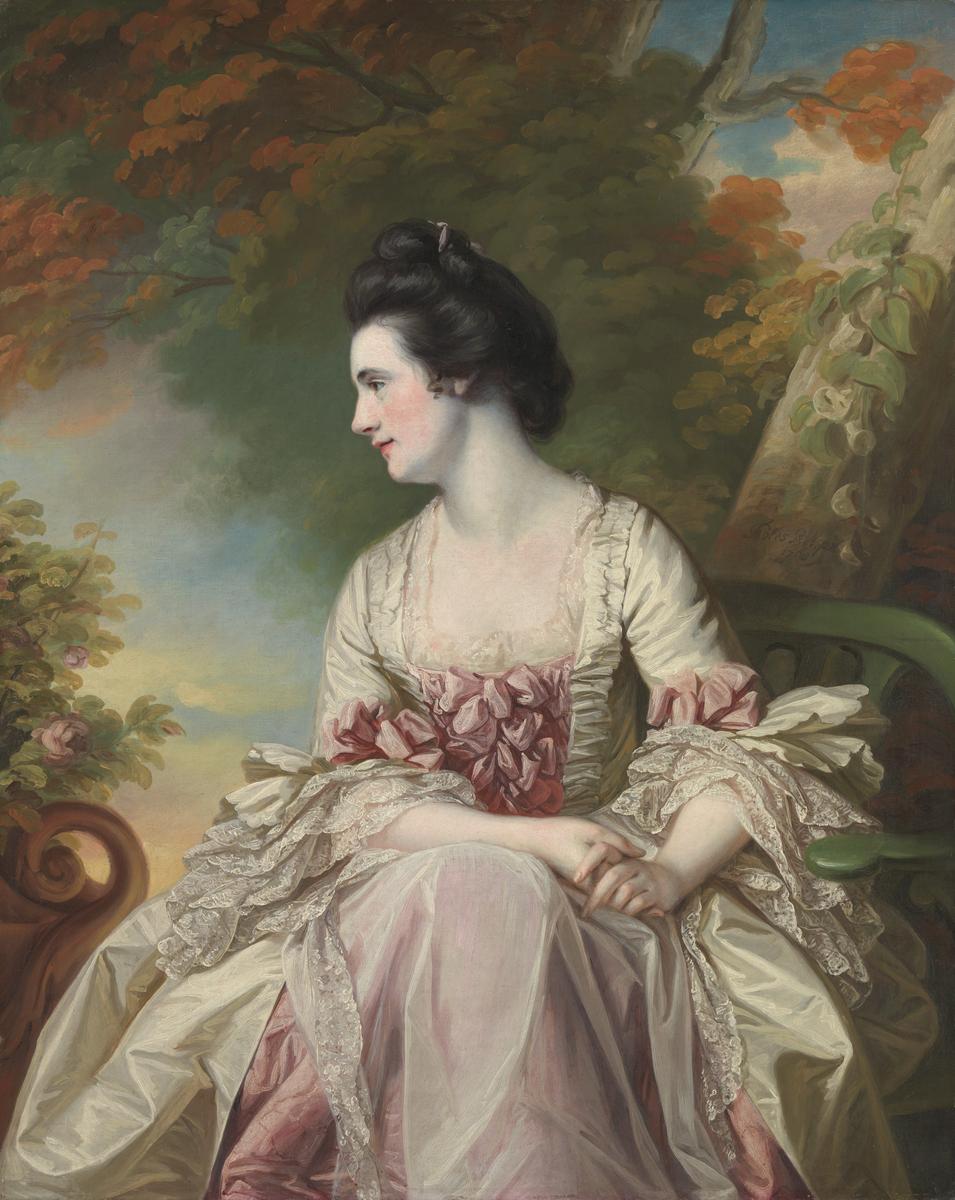
Francis Cotes, Portrait of a Lady 1768
This elegant and ornamental portrait
is a fine example of Cotes's style, which emphasises fashion rather than character. The sitter, whose identity is uncertain, sits on a garden bench in an artificial yet striking pose. Her gown and its lace are arranged decoratively about her, the pink and white colouring echoed by the foxgloves behind her, and the roses on the left. The portrait was painted in 1768, the same year as the foundation of the Royal Academy. Cotes was one of its founder members, which his prominent signature on the tree trunk, 'F Cotes RA px', proudly announces.
Gallery label, February 2010
24/30
artworks in 1760–1830
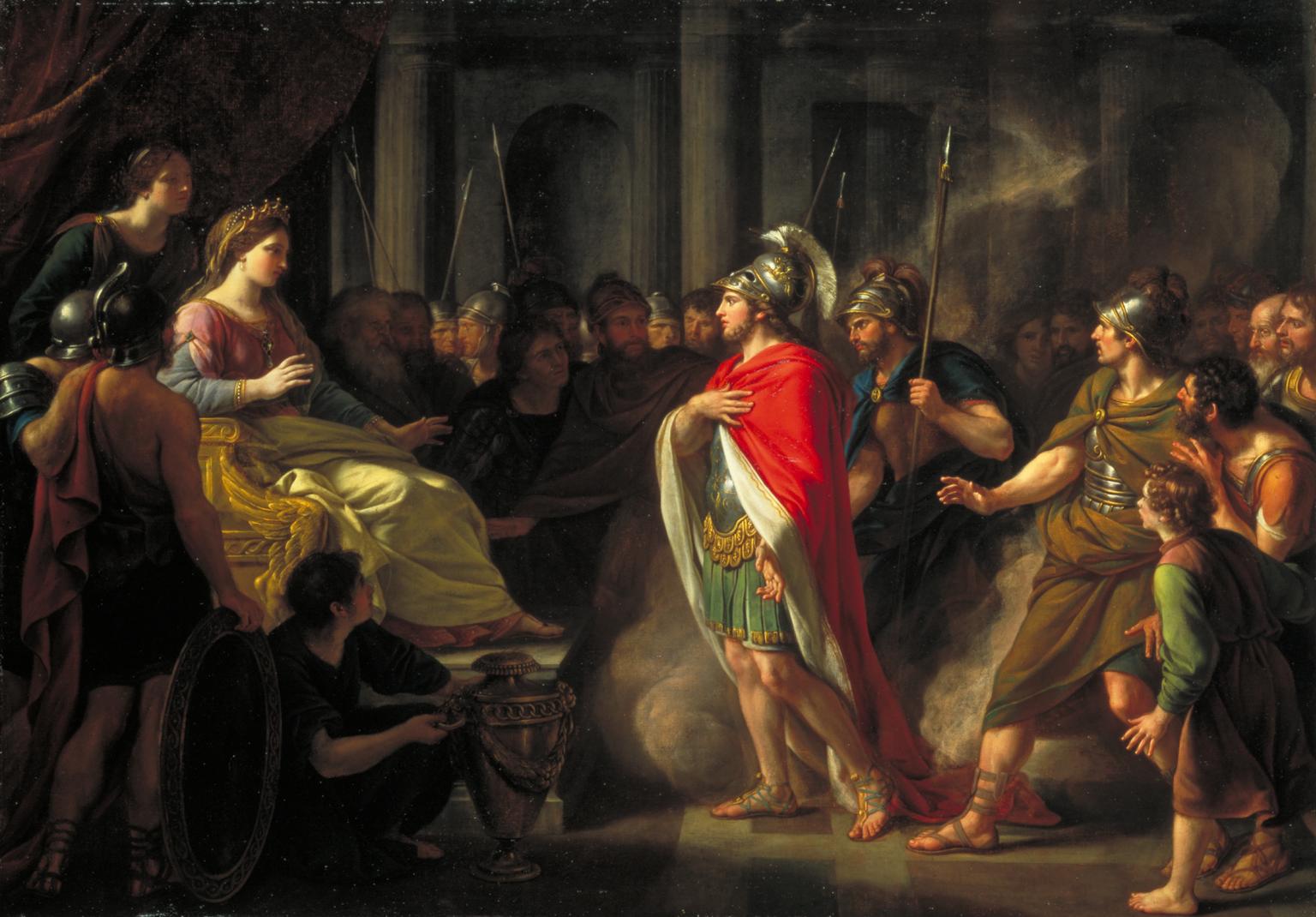
Sir Nathaniel Dance-Holland, The Meeting of Dido and Aeneas exhibited 1766
This picture shows the meeting of the Trojan prince Aeneas and the Carthaginian queen Dido, from Virgil’s epic poem, the Aeneid. Aeneas was shipwrecked near Carthage after the sack of Troy. The goddess Venus made Dido fall in love with him and helped him to hide in her citadel. He watches Dido welcome his fellow Trojans and when she asks to see their ‘king’ the mist clears and Aeneas reveals his identity. Dance-Holland made this picture while he was in Rome and sent it to London to be exhibited as a way to advertise his imminent return to Britain.
Gallery label, February 2016
25/30
artworks in 1760–1830
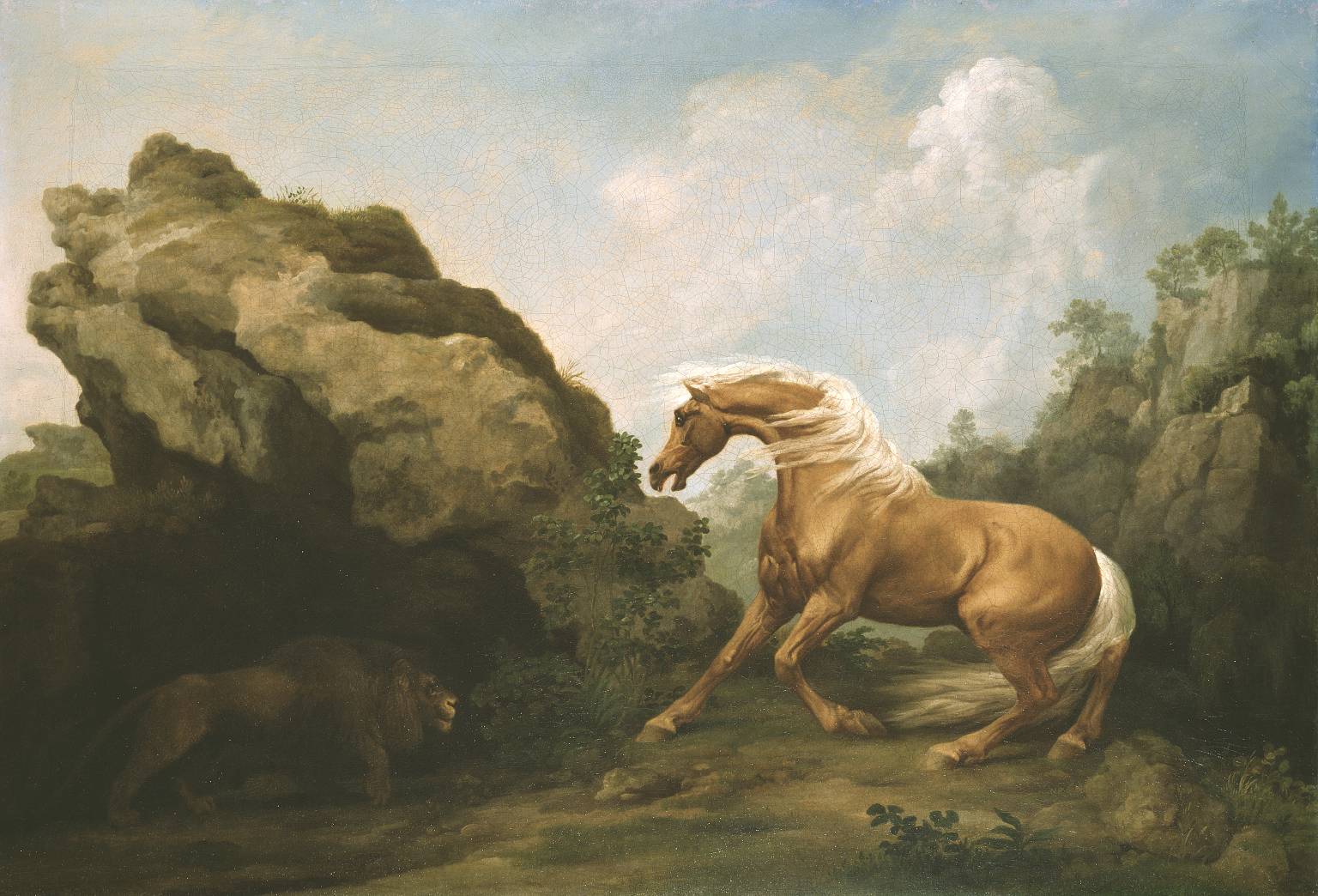
George Stubbs, Horse Frightened by a Lion ?exhibited 1763
The dramatic theme of a lion attacking a horse preoccupied Stubbs for over thirty years. This painting comes from a series of four episodes in a terrifying attack on a passive horse. This is the first stage, as the horse scents the lion emerging from its cave and rises up in fright. The setting for this violent encounter is the harsh, rocky landscape of Creswell Crags in the Peak District. The area was then an inaccessible, wild region that fascinated Stubbs. The scenery makes a suitably romantic background for the ‘sublime’ drama of the scene.
Gallery label, February 2016
26/30
artworks in 1760–1830
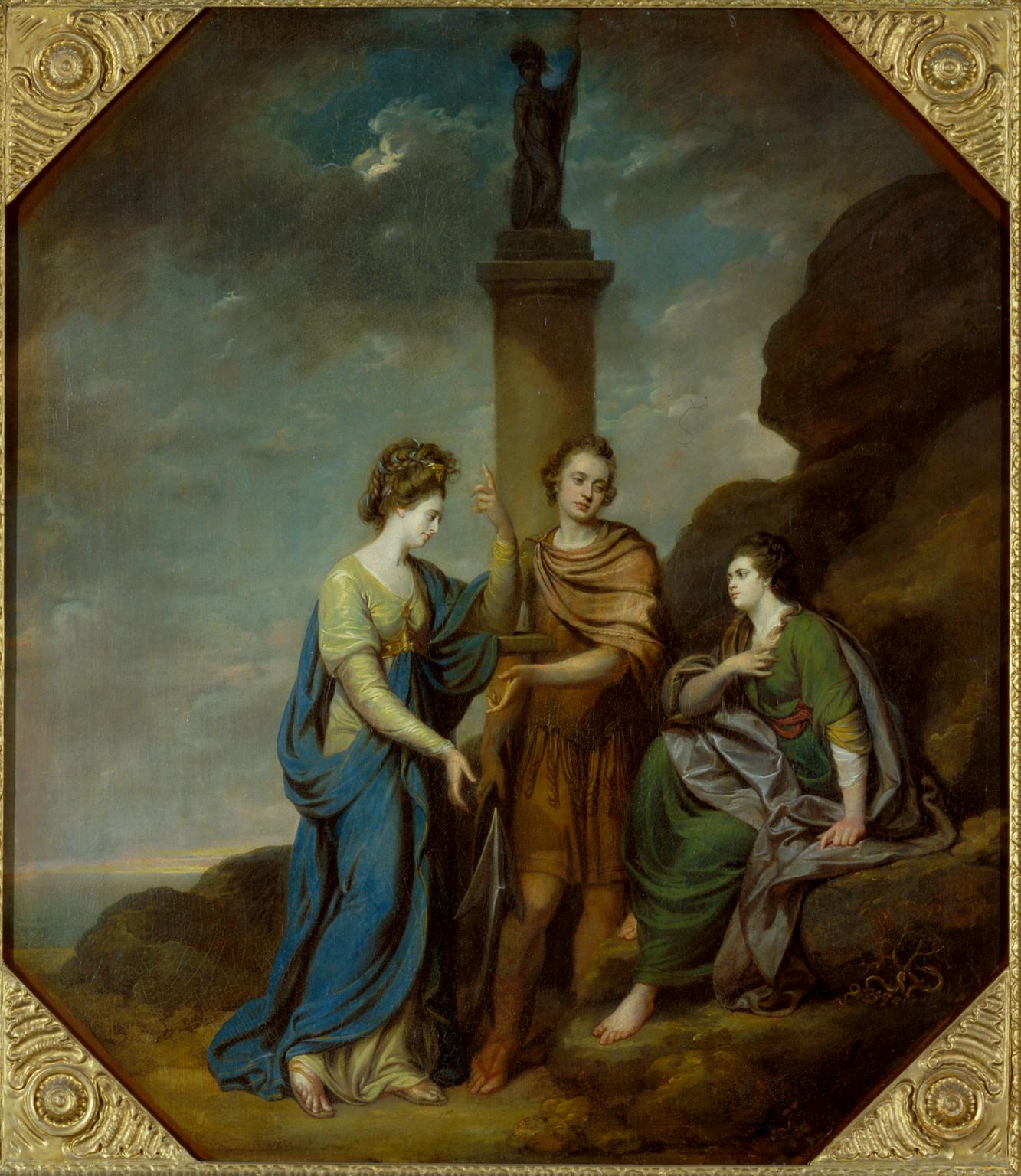
Richard Cosway, Portrait of a Gentleman, his Wife and Sister, in the Character of Fortitude introducing Hope as the Companion to Distress (‘The Witts Family Group’) c.1775
Although principally a portrait miniaturist (see cabinet 2: The Portrait Miniature in the Eighteenth and Nineteenth Centuries), Richard Cosway also produced some larger-scale works in oil. This allegorical portrait was painted following the death of a young London linen draper, Broome Witts, in 1769. Witts is shown here in the role of Fortitude, introducing his sister Sarah in the guise of Hope (left) to his wife Elizabeth, depicted as Distress. This memorial image was presumably commissioned by one or both of these ladies.
Gallery label, August 2004
27/30
artworks in 1760–1830
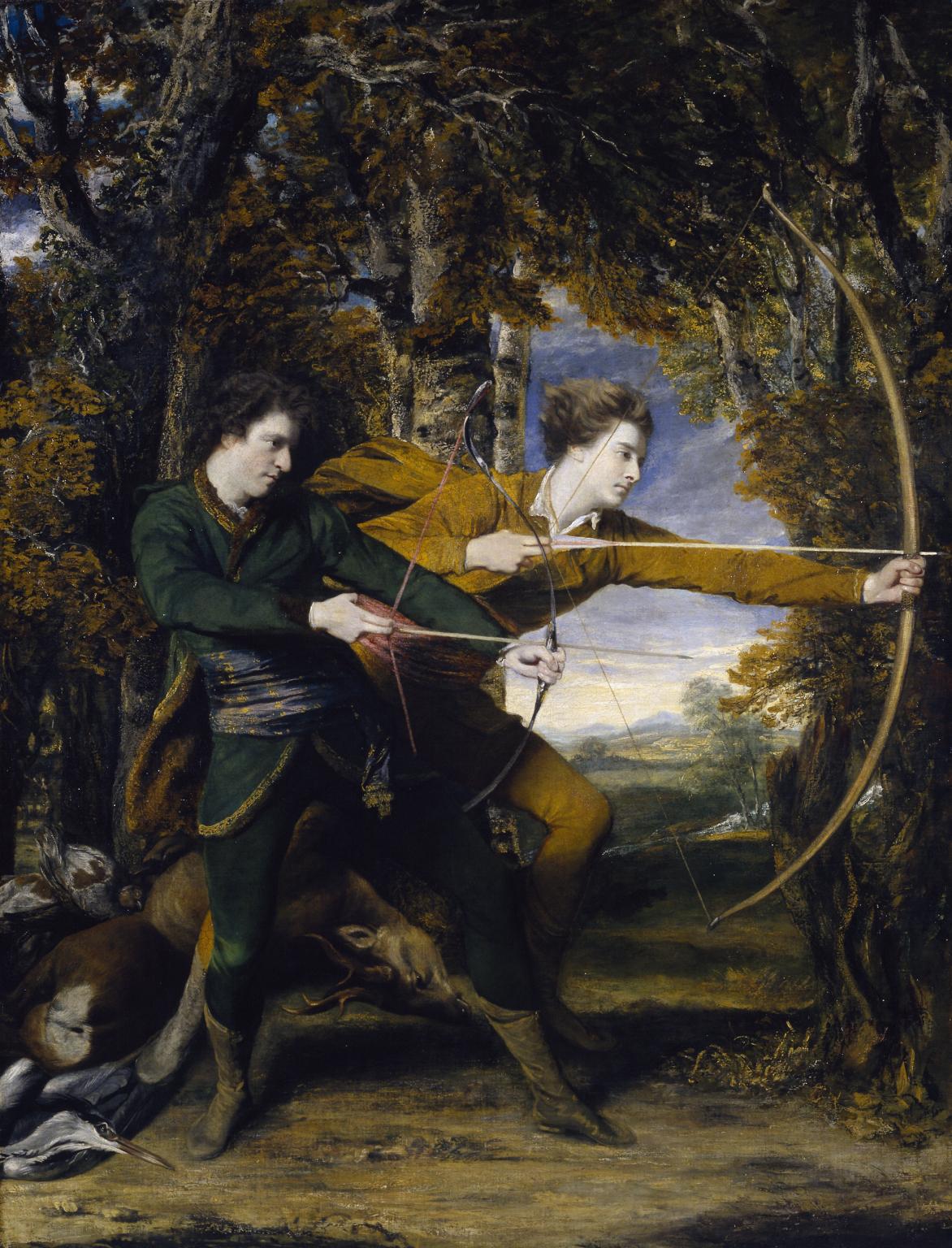
Sir Joshua Reynolds, Colonel Acland and Lord Sydney: The Archers 1769
This portrait depicts two young aristocrats. Dressed in quasi-historical clothing invented by the artist, they are mimicking a medieval or Renaissance hunt; the dead game they leave in their trail underlining their noble blood and aristocratic right to hunt. This painting celebrates their friendship by linking it to an imaginary chivalric past, when young lords pursued ‘manly’ activities together against a backdrop of ancient forest. The subjects are shown in perfect harmony – at one with each other and joint masters over nature.
Gallery label, February 2016
28/30
artworks in 1760–1830
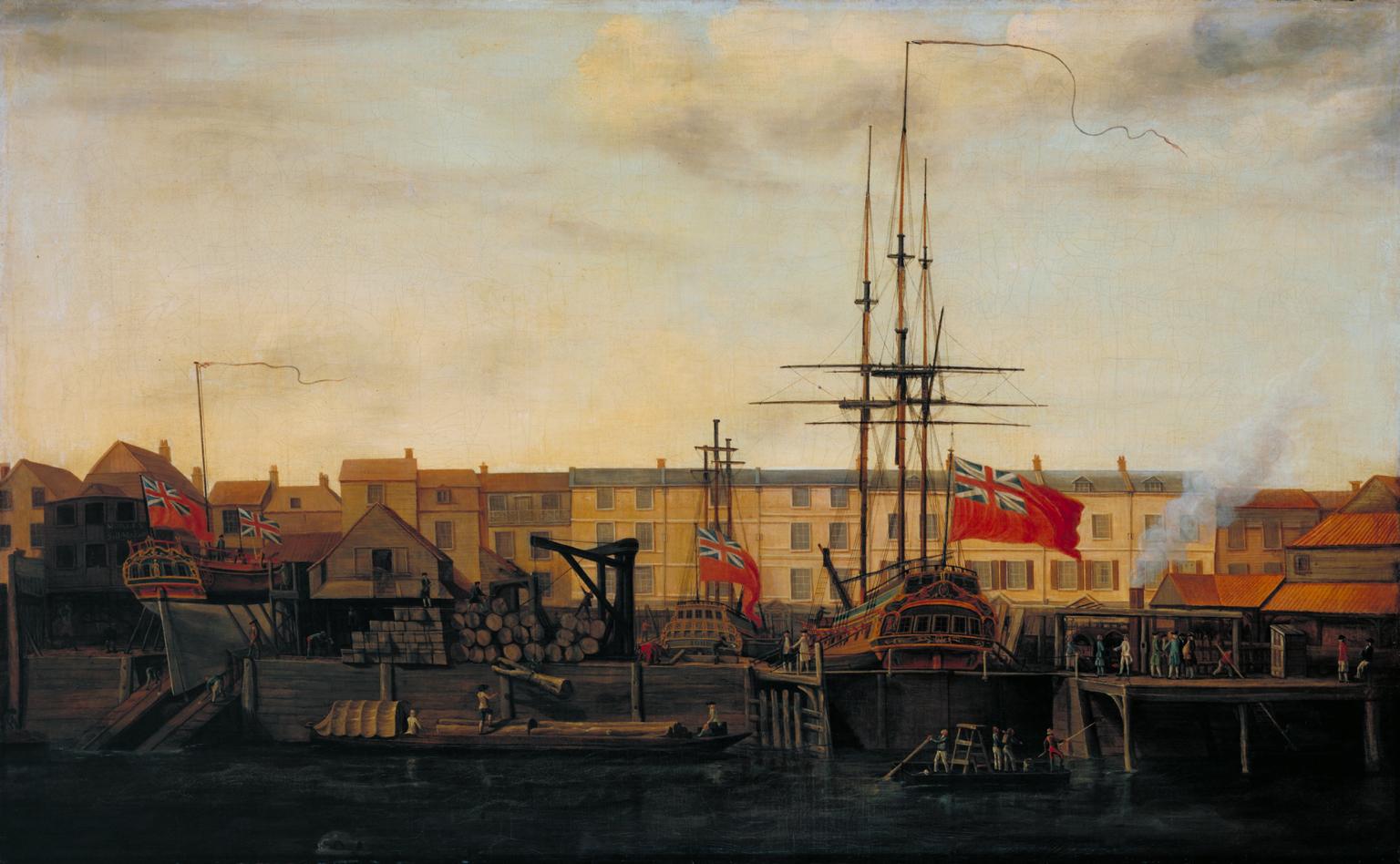
Francis Holman, A Dockyard at Wapping c.1780–4
Little is known about the artist Francis Holman. He was a painter of seascapes, ship's portraits and dockyard scenes, such as this small private dockyard on the Thames at Wapping. It is recorded that at one time Holman lived at Wapping, so he would have been intimate with the area and well able to execute this topographically accurate scene. He depicts with care the busy action of the dock, with ships in dry dock, and men unloading cargo. Even the sailmaker's firm of Morley, which is inscribed on the sign on the building to the extreme left, is known to have existed, directories listing it in Wapping until 1784.
Gallery label, August 2004
29/30
artworks in 1760–1830
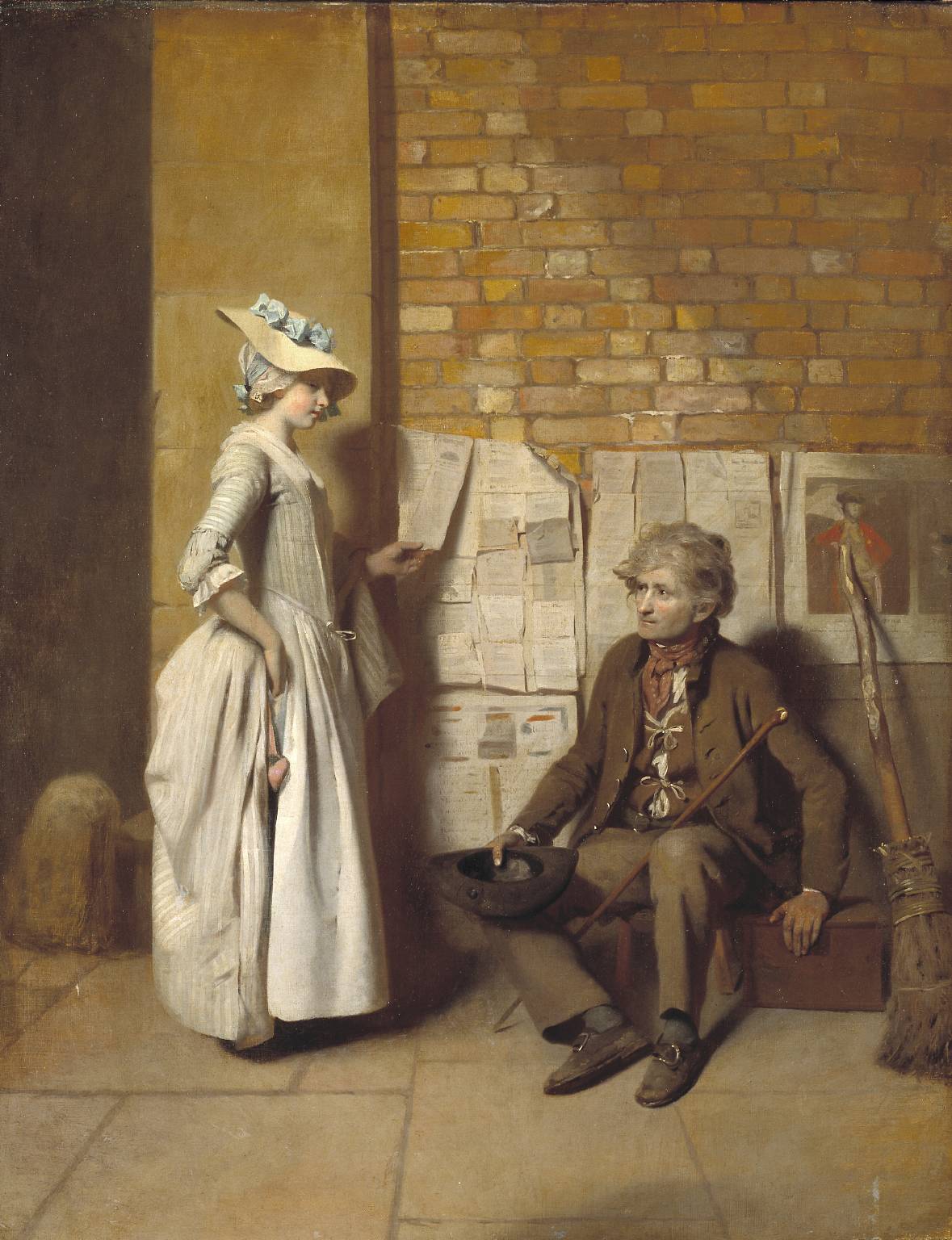
Henry Walton, A Girl Buying a Ballad exhibited 1778
The distant war for American independence (1775–1782) had an immense and divisive effect on London opinion, which was often very sympathetic to the American cause. There were, of course, many satirical prints, both for and against the Americans.
The war also occasionally had an indirect presence in paintings of contemporary life. The prints displayed by the ballad seller in Walton’s painting include a portrait of General Sir William Howe, commander-in-chief of the British forces in America. He had complained about government interference in the war and had resigned his commission.
Gallery label, September 2004
30/30
artworks in 1760–1830
Art in this room






























You've viewed 6/30 artworks
You've viewed 30/30 artworks
